Our oceans are incredibly special and whether you like going to the beach or not, or if you’re terrified of the ocean and wouldn’t get near it with a 10-foot pole, you’re still connected to it. The ocean is the largest livable habitat on the planet. It’s also the one we know the least about. In fact, we know more about the moon than we do the ocean. There’s a lot of incentive for people to want to conserve our oceans, but hopefully, this marine wildlife bucket list helps inspire you!
There are all sorts of special awareness days, especially in the summer, for the oceans – Mother Ocean Day, World Oceans Day, Shark Awareness Day, World Reef Day, and the list goes on.
There are 233,810 known species in the ocean (as of June 8, 2020) — and as many as 2 million more that remain a total mystery. No wonder some people are terrified. Me? I’ll be friends with the sharks if they’ll let me.
For this post, I asked 25 other travelers to share some of their favorite marine wildlife experiences they’ve ever had. Let me know which ones you’ve added to your bucket list now!
Table of Contents
Birds
Penguins in Antarctica
Contributed by Halef and Michael of The Round the World Guys
Without a doubt, Antarctica is one of the most unique wildlife-watching destinations in the world.
The Antarctica Peninsula and its surrounding islands are located just two days by ship from Ushuaia in Argentina – the southernmost city in South America. It’s an adventure itself to cross the infamous rough seas of the Drake Passage.
During your trip to “The Last Continent,” you’ll find several species of seals, whales, penguins, and other birds. My favorite excursion was a visit to Half Moon Island, located next to Livingston Island. Here you will find (and closely observe) three different species of penguins, Chinstraps, Gentoos, and Macaronis. Although you are not permitted to approach wildlife in Antarctica, that rule doesn’t apply the other way around. So if you can find a good place to sit down and stay still, very often curious penguins may waddle your way to check you out (penguins don’t obey treaties.)
To increase your chances of getting as close as possible to these creatures, simply find a place to sit nearby and don’t move. While it is prohibited for humans to initiate contact with Antarctica’s wildlife, that doesn’t mean it applies the other way around. It’s possible, even likely, that one or two penguins may be curious enough about you to come by to check you out.
So, dress warmly for Antarctica, sit quietly on a rocky beach near the Gentoo colony, and wait for it. It’ll be the highlight of your trip to the continent!
This post may contain affiliate links. Please see our disclosure.
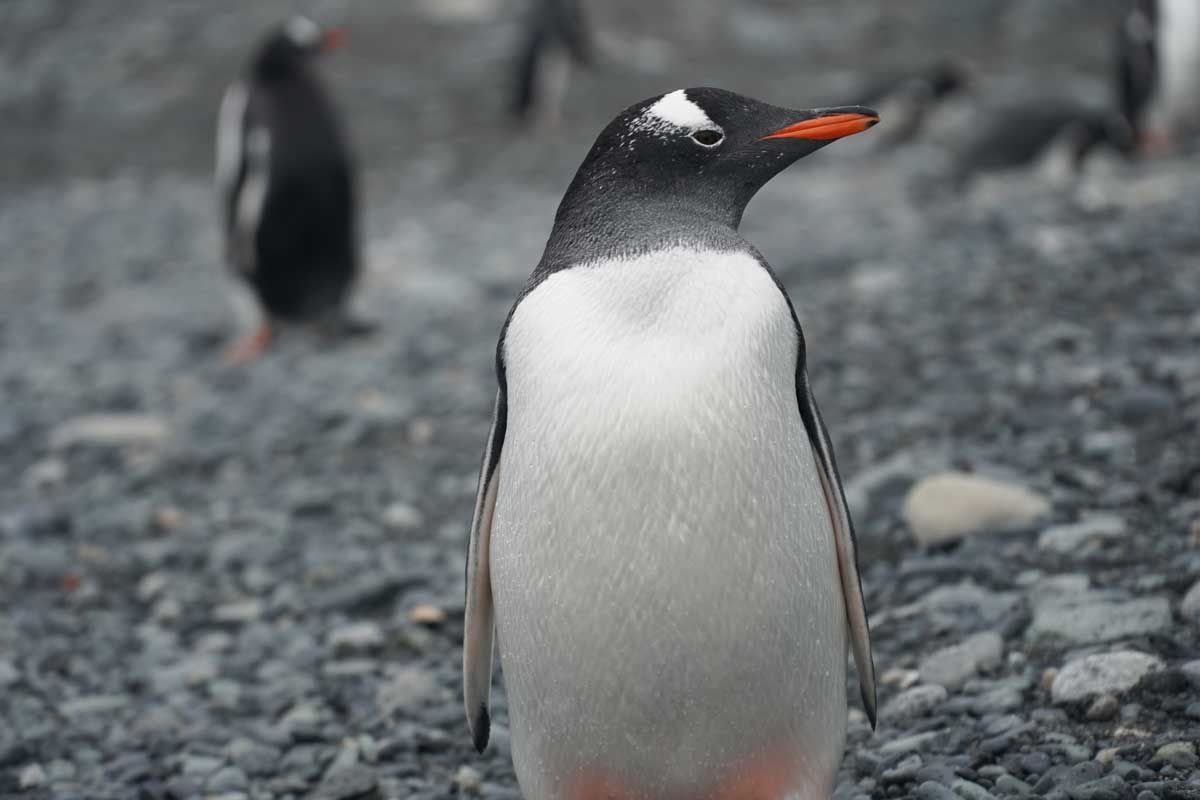
Atlantic Puffins in Wales
Contributed by Christa & Nathan of Expedition Wildlife
Birds aren’t often the first animal that comes to mind when considering marine wildlife. However, certain bird species spend over half their life on the open ocean! One such beloved seabird is the Atlantic Puffin, found in and along the coasts of the North Atlantic Ocean.
Dubbed the “clowns of the bird world” for their orange flippered feet and brightly colored beak, puffins have inspired people to travel around the world to see them. One of the best places to spot puffins is on Skomer Island, Wales. This small island is owned and managed by the Wildlife Trust of South and West Wales, so visitors have the opportunity to learn about this special conservation hotspot with the help of on-site volunteers.
Easily walkable trails allow visitors to see all manner of birds and other wildlife, including a large puffin colony. They’ll be so close that you may actually have to watch where you step on the trail! Just don’t go off-trail, as the many surrounding burrow holes are easily collapsible and may have a baby bird within.
Puffins live on land during their breeding season from April until late-July. After this, they go back to the ocean until the following spring. Getting to Skomer Island takes some planning, as only a limited number of people can visit in a day. Also, access requires a short ferry boat ride, so arriving at the Lockley Lodge visitor’s center early is key to secure a spot on the boat. Renting a car is the easiest way to get to the isolated visitor’s center and ferry point.
If you’ve dreamed of getting a close-up view of one of these stunning birds, visiting Skomer Island is a must!
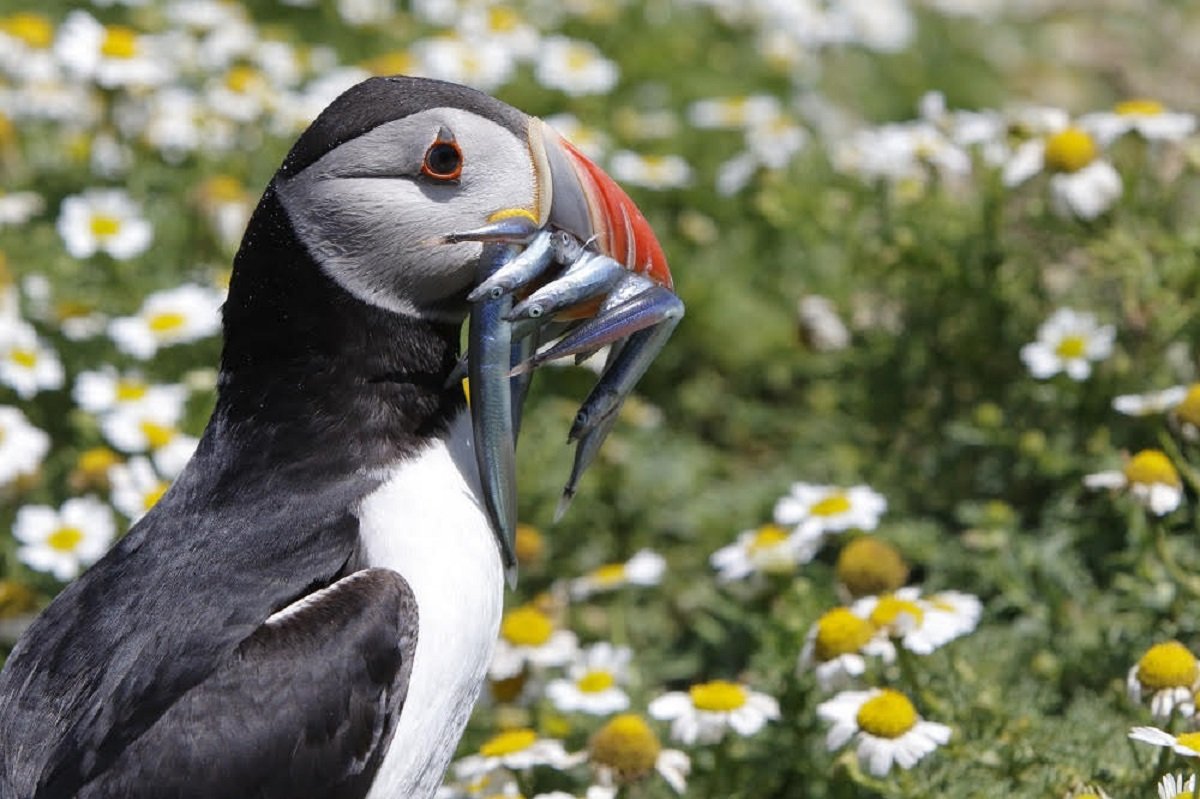
Swimming with Galapagos Penguins
Contributed by Bret Love & Mary Gabbett of Green Global Travel
Located some 850 miles off the west coast of mainland Ecuador (and remarkably close to the Equator), the Galapagos Islands archipelago is one of the few places in the world where travelers have a fairly decent chance to swim with penguins in their natural habitat.
Currently listed as Endangered by the International Union for the Conseration of Nature (IUCN), Galapagos Penguins are among the most rare penguin species on the planet. According to recent research, less than 1000 breeding pairs remain in the wild.
But if you take one of the many small ship cruises of the Galapagos, you’re virtually guaranteed to see them on the western islands of Fernandina and Isabela (especially around Tagus Cove). You may also see small populations on Floreana, northern Santa Cruz, and Santiago. Galapagos Penguins are fascinating creatures. They’re on the small side as penguins go, measuring just 19 inches long and weighing 5 pounds. The tiny waterfowl have genetically adapted to the heat of the Galapagos (59º-82ºF), regulating their body temperature by stretching out their flippers, avoiding the sun, panting and swimming in the islands’ cool waters.
You’ll usually see them all year round, sunning themselves on the shore or shooting like rockets underwater in search of a snack. But my favorite encounter came during a snorkeling expedition off the coast of Bartolome, which is home to the iconic landmark known as Pinnacle Rock. That’s where a pair of curious penguins hopped into the water right beside our group of travelers, and swam nearby (and ultimately right alongside us) for more than 20 minutes!
If you do get this rare and unique opportunity during your visit to the islands, consider yourself VERY lucky: Our local guide said it had only happened to her once in 17 years of working in the Galapagos Islands!
Cephalopods
Giant Australian Cuttlefish
Contributed by Natalie & Steve of Curious Campers
Giant cuttlefish will appeal to anyone who appreciates all that is weird and wonderful in nature. When tens of thousands of Giant Australian Cuttlefish arrive to breed near Whyalla it is a unique wildlife spotting experience. The season runs from June to the end of August.
Up to half a meter in length, the cuttlefish are fascinating to watch. They can propel themselves forwards and backward. As they swim, their bodies pulse with iridescent colors. They are masters of disguise and you can see them change color to match their environment right in front of you.
Whyalla is 400 km north of South Australia’s capital Adelaide. Road conditions between Adelaide and Whyalla are excellent although lookout for big trucks. There is also a bus service between the two cities.
Stony Point, 20 km from Whyalla, is the best place to see the cuttlefish. One of the great things about this experience is how accessible it is. You can wade into waist-deep water, look down and see them.
You can dive or snorkel at the site. Water depth is generally less the 5 meters. Snorkellers will see cuttlefish in just a couple of meters of water. Stony Point has a big carpark, toilet, and change facilities. There is a chain rail into the water which is handy if you are juggling diving gear and a camera.
The main issue for this experience is the cold. This is a winter activity and the water temperature is around 12 degrees Celsius. You’ll need a thick wetsuit or drysuit, boots, gloves, and hood. The longest we stayed in the water was 45 minutes.
Don’t be put off, the cold is part of the adventure, and seeing the cuttlefish is an experience you will never forget.
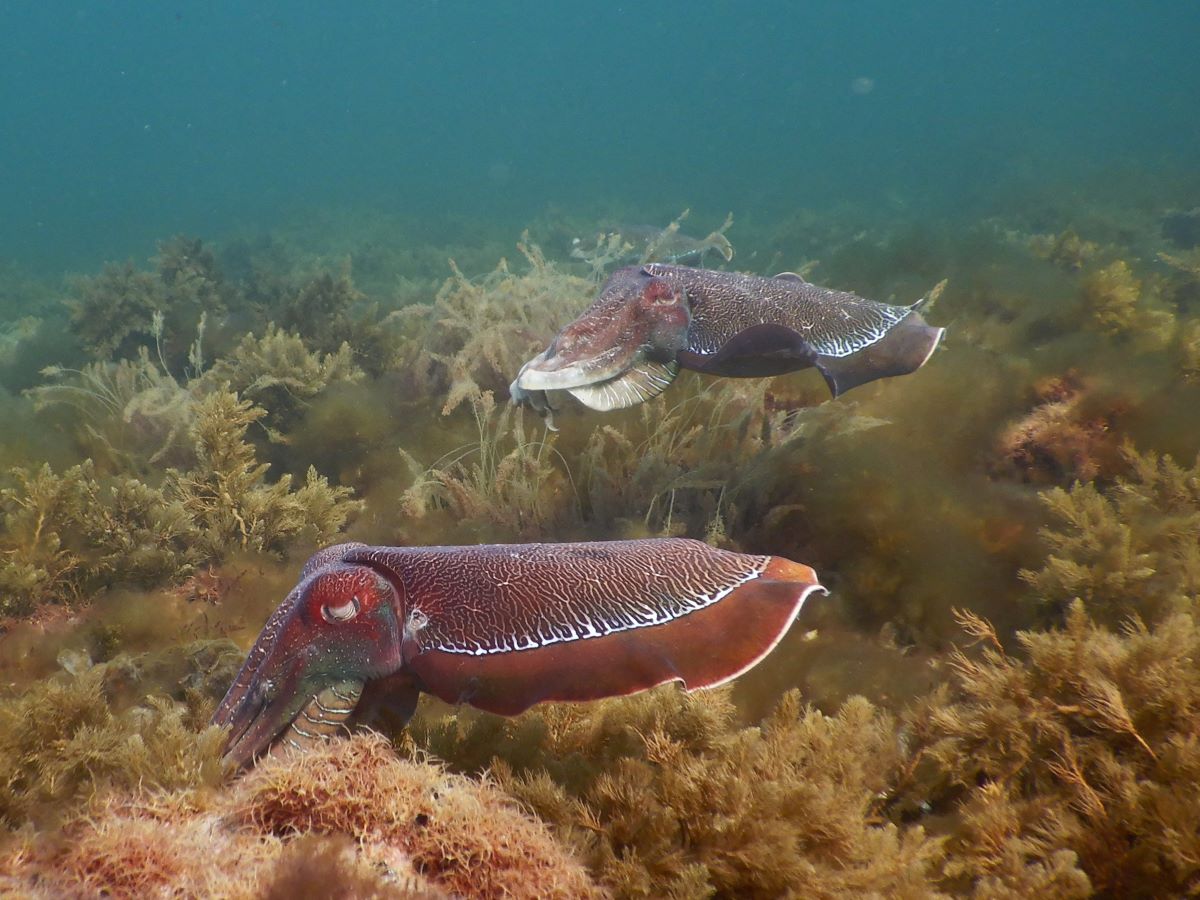
Dolphins
Pink Amazon River Dolphin in Perú
Contributed by Heather of Trimm Travels
For the marine wildlife lovers out there, the Amazon River Dolphin or Pink River Dolphin (“boto” in Spanish) is a unique animal that must go on your bucket list. The botos can be found throughout the Amazon and Orinoco Rivers and their tributaries in several South American countries. They were an important bucket list photo for Perú alongside Machu Picchu because I had to see this beautiful pink species! I arranged a private boat tour through the owner of our accommodation prior to arriving in Iquitos, Perú, the gateway to the Amazon. Our guide was very familiar with the famous dolphins and was eager to help us find them. They can be somewhat elusive especially during the birthing season which typically occurs July-September but can also occur May-June. Since it was late May, we knew a sighting might be a little difficult. However, we found this mom and her baby and I was able to snap a photo. The mom (tails up) was pink and the baby (heads up) was gray. Calves are born gray and become pink in adulthood due to repetitive natural skin abrasions. While both males and females turn this beautiful bubble gum pink, it is more prevalent in males. This is due to their aggression including trying to impress the females during mating season. To find these beautiful animals in Perú, you need to know a few things. Timing is important especially if you want to see babies right after birth. Also, they tend to move upstream June-November which is the low water season of the Amazon River Basin. Iquitos is the largest city in the world not accessible by road so you will need to book the 1.5-hour flight from the Peruvian capital of Lima. I recommend trying to book a private or small group tour through your accommodations or via an ethically responsible local. Do not book a tour to swim with the dolphins as these typically use bait to guarantee the swim. They can be spotted undisturbed in their element and it is a precious sight you shouldn’t miss!

Swimming with Dusky Dolphins in New Zealand
Contributed by Katie Diederichs of Two Wandering Soles
If you’ve ever dreamed of swimming with dolphins but thought it would be impossible outside the enclosures of less than ethical establishments, you’re in for a treat… There’s a small town in New Zealand where you can jump into the water as pods of wild dolphins encircle you!
The seaside town of Kaikoura is known for being a great place to spot whales as well as the dusky dolphin. Smaller than the many other related species, dusky dolphins are known for being extremely playful and having acrobatic abilities. You can witness their adorable and sprightly personalities for yourself by booking a spot on a tour.
Dolphin Encounters is the sole operator of this incredible experience in Kaikoura, and they have strict rules and regulations that they follow. They limit the number of swimmers as well as the amount of boats they send out each day, and they work with scientists to monitor the dolphins’ behaviors.
While it isn’t promised that you’ll see the dolphins, as they are wild creatures and not baited in any way, it is pretty rare that you wouldn’t encounter these playful creatures as the dusky dolphins are very curious.
As long as you are comfortable jumping into cold water, you can experience this for yourself, as you don’t need any special skills and all the necessary equipment is provided. Plus, swimming with dolphins can be done all year round. No matter the time of year, the waters in Kaikoura are frigid (yes, even with a wetsuit on!). But as soon as you hear the chattering dolphins and see them swim around you joyfully, it is worth every goosebump!
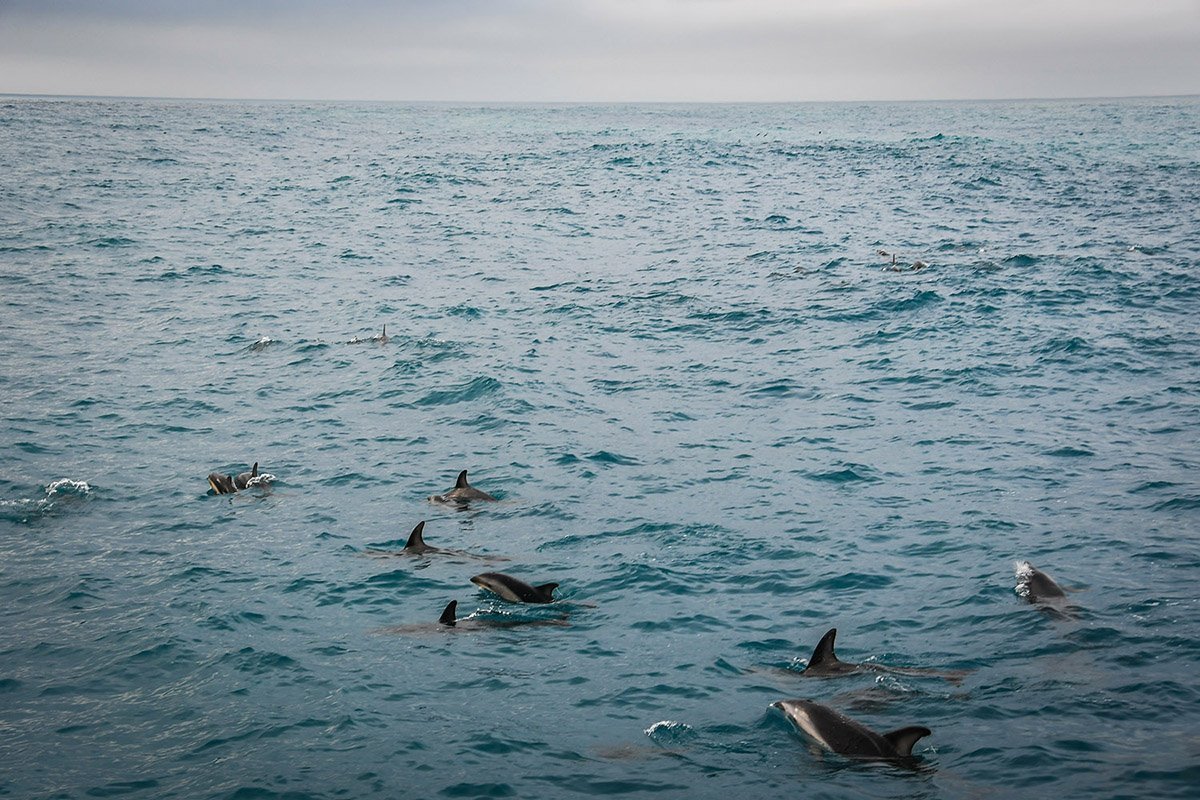
Fish
Whale Sharks in Puerto Princesa, Palawan, the Philippines
Contributed by Brianne Miers of A Traveling Life
Swimming with the world’s largest fish in the warm waters of the Philippines is an experience that should be at the top of every ocean lover’s bucket list. Whale shark encounters are offered in many locations throughout the country’s 7,000 or so islands; however, some of the most popular – Cebu, in particular – are known to promote irresponsible behavior such as feeding and touching.
For a less crowded and more ethical experience, I highly recommend heading to Puerto Princesa, Palawan, between April to October (the specific timing is synced with the full moons).
For my whale shark swimming experience, I took a day trip with Dolphin and Whales Travel and Tours, one of the oldest and most respected outfitters there. They took our group of about 15 tourists an hour out into Honda Bay.
Once we were in whale shark territory, the guides – all locals – kept their eyes glued to the horizon, using the fish and birds to point them in the direction of the whale sharks (A few times we encountered fishermen who were willing to help us out, too.) As soon as we got close enough to a pod, they’d give us the signal to jump in. We’d paddle around until the whale sharks got bored with us and swam off, then we’d climb back on the boat and keep going in search of more.
Given that whale sharks can grow up to 40 feet, being so close to these gentle giants that day was absolutely exhilarating. Of course, there was absolutely no feeding or touching – being in their presence was memorable enough.
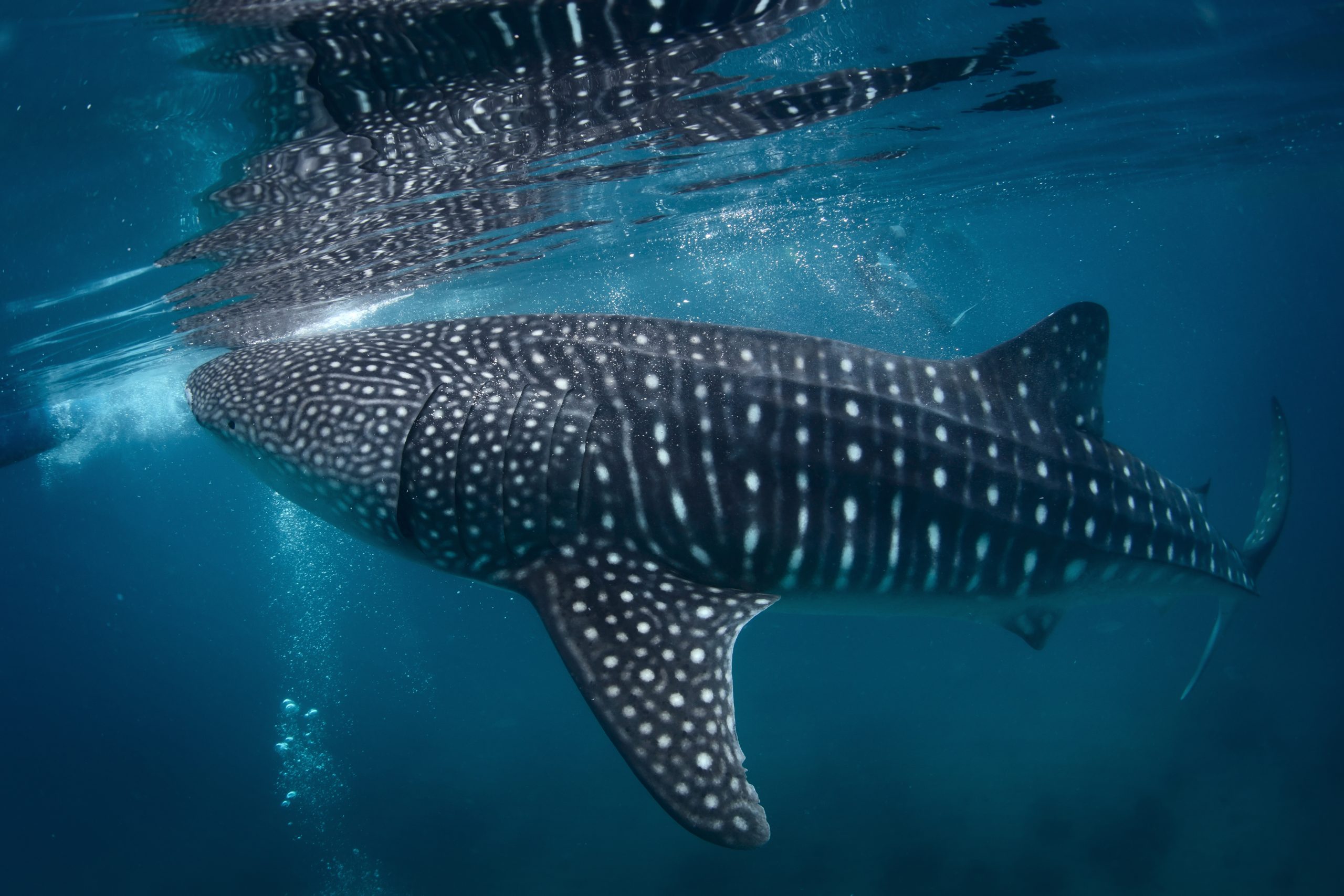
Whale Sharks in Koh Tao, Thailand
Contributed by Carine & Derek of We Did It Our Way
Back in March 2018, we were on our long-term trip and spent a few weeks in Koh Tao, Thailand. This is one of the cheapest places on earth to learn how to scuba dive. So we did what any traveler on a budget would do – we got our Open Water certification. But getting our certification ended up becoming one of the most unreal and unexpected experiences of our lives because we got to see one of the largest fish in the ocean, a whale shark.
If there’s one marine animal that’s on every scuba diver’s (or any person’s) bucket list, it’s the whale shark. Our scuba instructor, a seasoned diver, has only seen it a handful of times, while other instructors told us that even after a thousand dives, they had yet to see one! So we knew this was a once-in-a-lifetime experience!
Of course, there are plenty of places to see whale sharks, but they are not ethical, at all. As eco-travelers, we did not want to support these places. This is the main reason we got our scuba certification in the first place. We wanted to see these giant fish without disrupting their ecosystem.
If you’re hoping to see the whale sharks or other big pelagics in Koh Tao, September is the best time to see them. However, we saw ours in March, so it’s still possible year-round.
Beyond being an affordable place to learn to dive, Koh Tao is a great place to be. The food is good and cheap, the beaches are lovely, the people are sweet and there’s always a party going on!
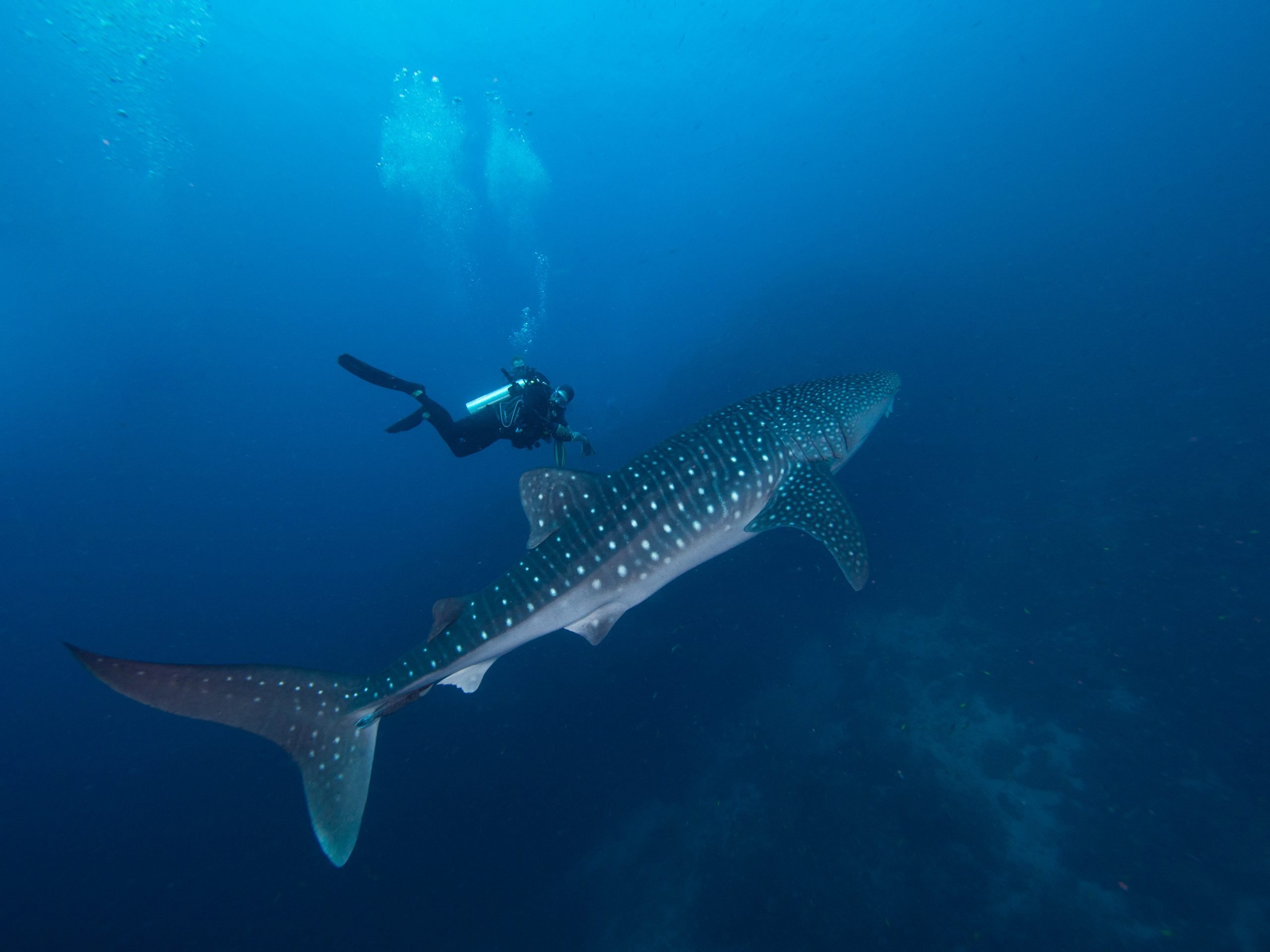
Sardine Baitball in Moalboal, Philippines
Contributed by Luke of The Coastal Campaign
Moalboal in South Cebu is one of the most underrated destinations in the Philippines. While there are many amazing waterfalls and hikes in the surrounding area one of the main attractions in Moalboal is the ability to dive with giant Sardine bait balls just a few meters from the shore, right in the town center.
One of the cool things about swimming with the Sardines here is that you can choose to either snorkel or scuba dive with them. They only swim a few feet below the surface so it is easy to free dive and swim amongst the fish.
As you swim out from the beach you pass over a shallow area full of seagrass that is usually packed full of turtles, which is a great experience by itself. As you swim around 30 meters from shore there is a large shelf that drops off into the deeper ocean and this is where you will find the Sardines.
Tens of thousands of Sardines swim in unison creating huge schools of fish that move and sway together in hypnotizing motions. You can dive down and swim right through the middle of these bait balls and watch as the fish spread around you to allow you to swim through. We weren’t really sure how impressive this would be but we were blown away by how cool it was to have thousands of fish swirling around our heads.
Being able to enjoy an underwater experience this good just a few meters from the beach is awesome. And having to swim through a turtle feeding ground to get here makes it even better. The Sardine run is visible year-round but the best time to visit is between November and May as these times offer the best visibility.
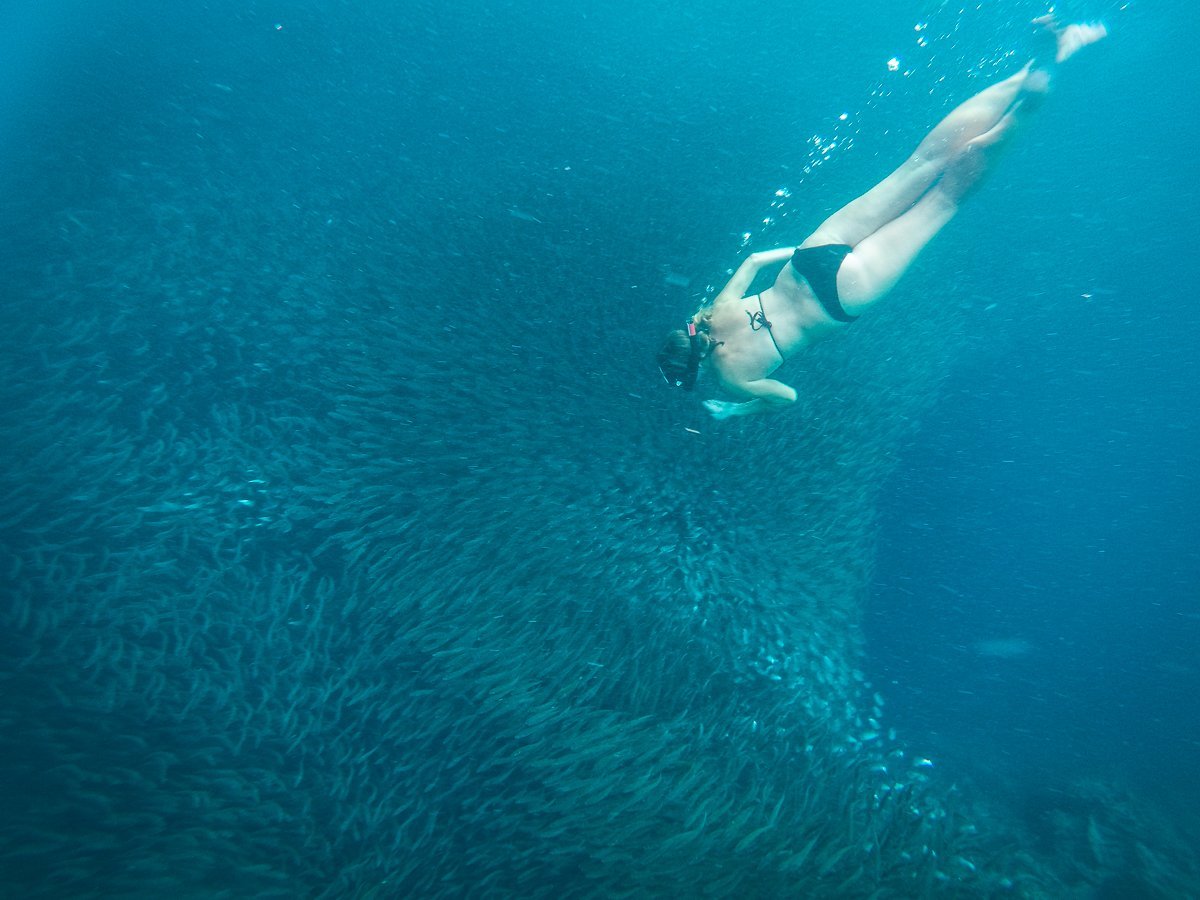
Manatees
Manatees in Crystal River, Florida
Contributed by Lori of Travlin Mad
Located on Florida’s Nature Coast on the western Gulf Coast, the town of Crystal River is a part of Florida many travelers never see. But if you love nature at its wildest and most pristine, this is a landscape truly worth exploring.
The limestone shelf and natural underground springs in this part of Florida create breathtaking turquoise pools that attract the area’s most famous resident every winter — the protected West Indian manatee. Manatees congregate by the hundreds in the warm natural springs to keep warm from the dropping temps in the Gulf of Mexico. And while they are a protected species in Florida, this is an animal encounter that’s definitely worth having — getting in the water and swimming with manatees in Crystal River will make you their advocate for life! You don’t need a PADI certificate to swim with manatees, as you won’t really dive down in the water. Book a local reputable manatee tour, put on the wetsuit, mask, and snorkel provided, grab your noodle, and float in the water, letting the manatees come to you as you passively observe them in the wild. The curiosity and playfulness of these naturally gentle giants will have them coming around to greet you, so don’t forget to bring your underwater GoPro or waterproof cell phone cover.
If ever there was an educational and exciting encounter for your Marine Animal Bucket List, it’s the famous manatees of Crystal River!
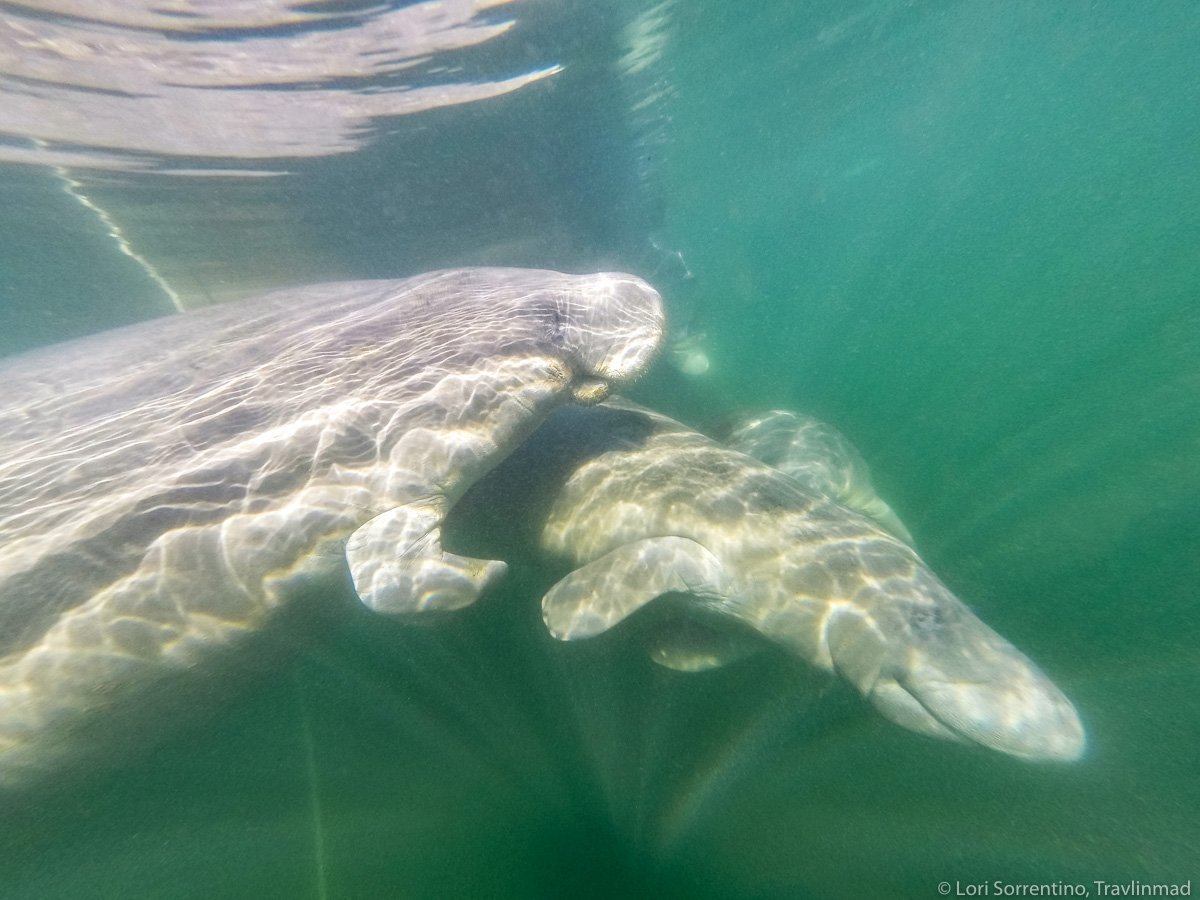
Polar Bears
Polar bears in Svalbard or Churchill
Contributed by Amanda of A Dangerous Business
Because they live in the far northern reaches of the world (and because there aren’t that many of them left), a lot of people will never see a live polar bear outside of a zoo. But you CAN see polar bears in the wild if you’re willing to spend a bit of money and don’t mind the cold.
There are two especially great places to see polar bears (the only bear species in the world to officially be classified as a marine mammal, did you know?) in the wild. The first is Svalbard, an island group in the North Atlantic, and the second is the small town of Churchill, Manitoba, which has earned the nickname of the “Polar Bear Capital of the World.”
Summer cruises around Svalbard often provide opportunities to view polar bears in their natural habitat from afar. But if you want to get up close and personal with the great white bears, then you’ll need to go to Churchill.
Each year in October and November, the Western Hudson Bay population of polar bears (roughly 1,000 bears) congregates in the Churchill area for a few weeks, waiting for the nearby Hudson Bay to freeze over.
Several companies in Churchill offer polar bear tours, which usually entail riding around the Churchill Wildlife Management Area in purpose-built tundra vehicles to look for bears. Tours are the only way to visit this area, and they have very strict rules about how vehicles (and people) can interact with the bears.
Churchill’s polar bears are conditioned to seeing the big tundra vehicles, much like wildlife in Africa is conditioned to seeing safari trucks. This means you can often observe the bears from a much closer (but still responsible) distance. A polar bear tour in Churchill is 100% worth putting on your wildlife bucket list.
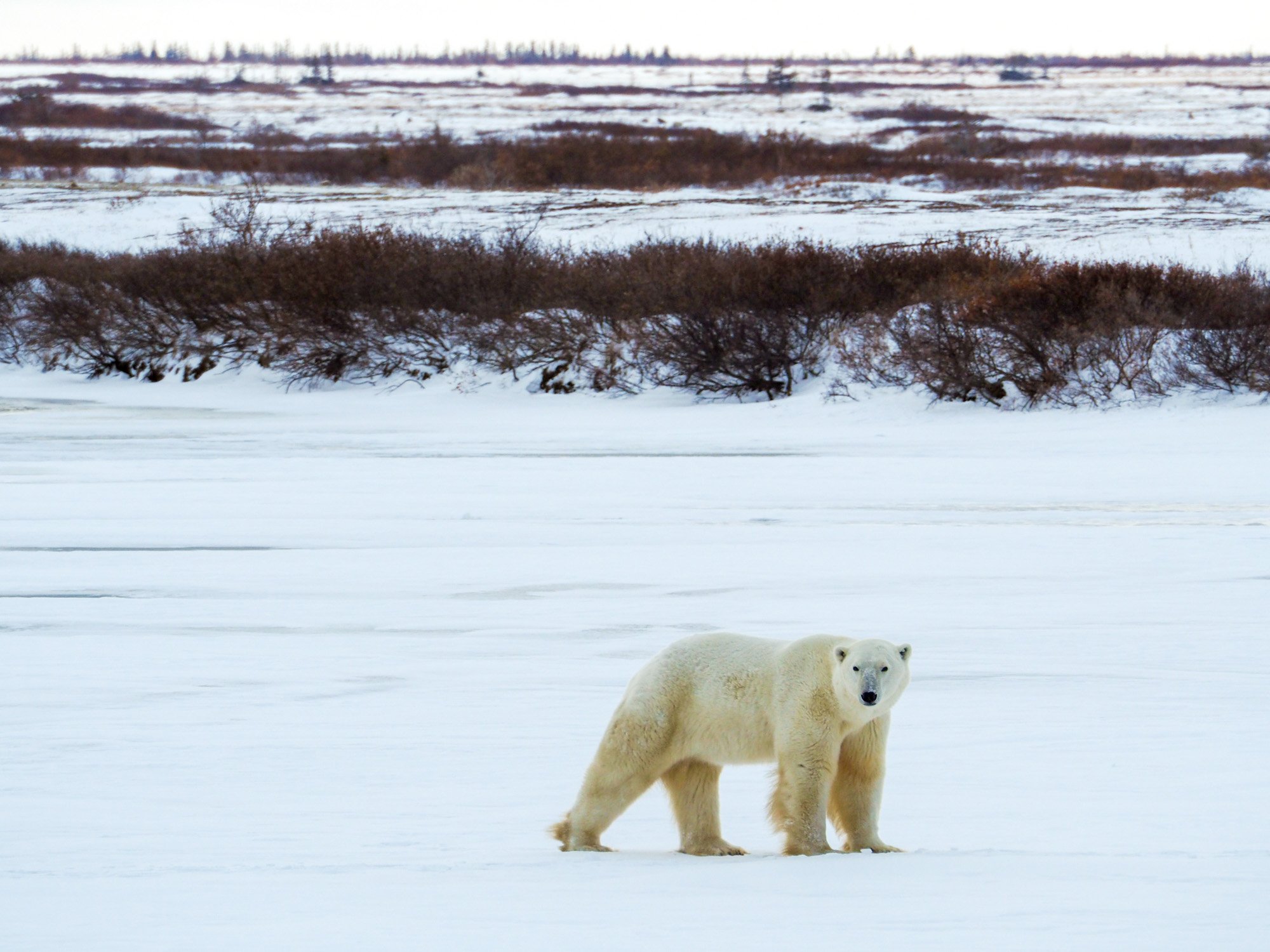
Rays
Spotted Eagle Rays in Costa Rica
I feel like I was very fortunate during my PADI Open Water certification in Costa Rica. I’m so happy I chose such a wonderful and biodiverse place to get my certification. During the four dives of my certification, I saw reef sharks, nudibranch, a sea snake, a ton of pufferfish, southern stingrays, rounded stingrays, eels, and so many fish I could never possibly remember.
What was really special though was the spotted eagle rays that I saw on both days. And, even more special, was the fact I saw a fever of five spotted eagle rays – a fever is what. a group of stingrays is called!
It’s actually not super common for them to travel in groups so this was extra special and I definitely think such a wonderful first experience has lit a fire and passion for the ocean.
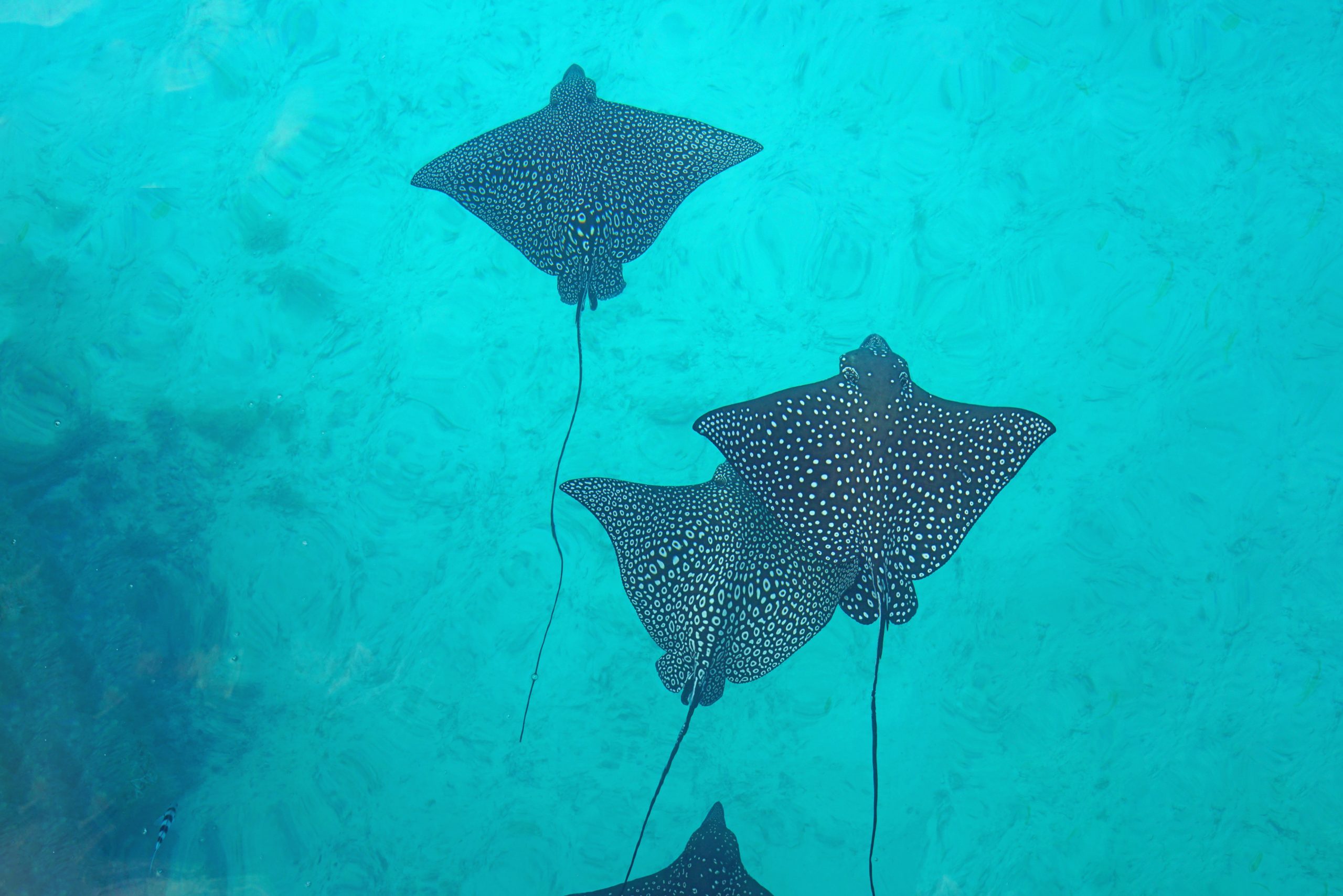
Manta Rays in Fiji’s Yasawa Islands
By Josh Shephard of The Lost Passport
Swimming with the Manta Rays in Fiji’s Yasawa Islands is an absolute must-have experience for marine animal enthusiasts. Each year these majestic rays feed in the narrow channel between Nanuya Balavu Island and Drawaqa Island (also commonly known as Barefoot Manta Island).
For the highest chance of encountering Manta Rays it is recommended to spend at least two nights on either one of these islands. The Manta Ray season runs from May through to October each year, pretty much half the year. This aligns nicely with Fiji’s non-cyclone season, or the dry season. During these months there are Manta Ray sightings in the channel almost every day. There are also the occasional sightings of Manta Rays outside of these months, but you are honestly quite unlikely to encounter one then.
The great news is that you do not need to be a qualified diver to swim with the Manta Rays. A snorkel and a set of flippers will do the job. However, it is worth noting that all trips must be taken with a tour guide costing roughly FJD 65 (USD 30) per person. This ensures that any direct interaction between visitors and the Manta Rays is limited and ensures your personal safety as the current in the channel can be quite strong. Trips run from 30 to 60 minutes in duration.
Getting to these islands is quite easy with the Yasawa Flyer, an island-hopping purpose-built catamaran which departs Nadi each morning. The trip from Nadi to Drawaqa Island takes about 3 hours one way.
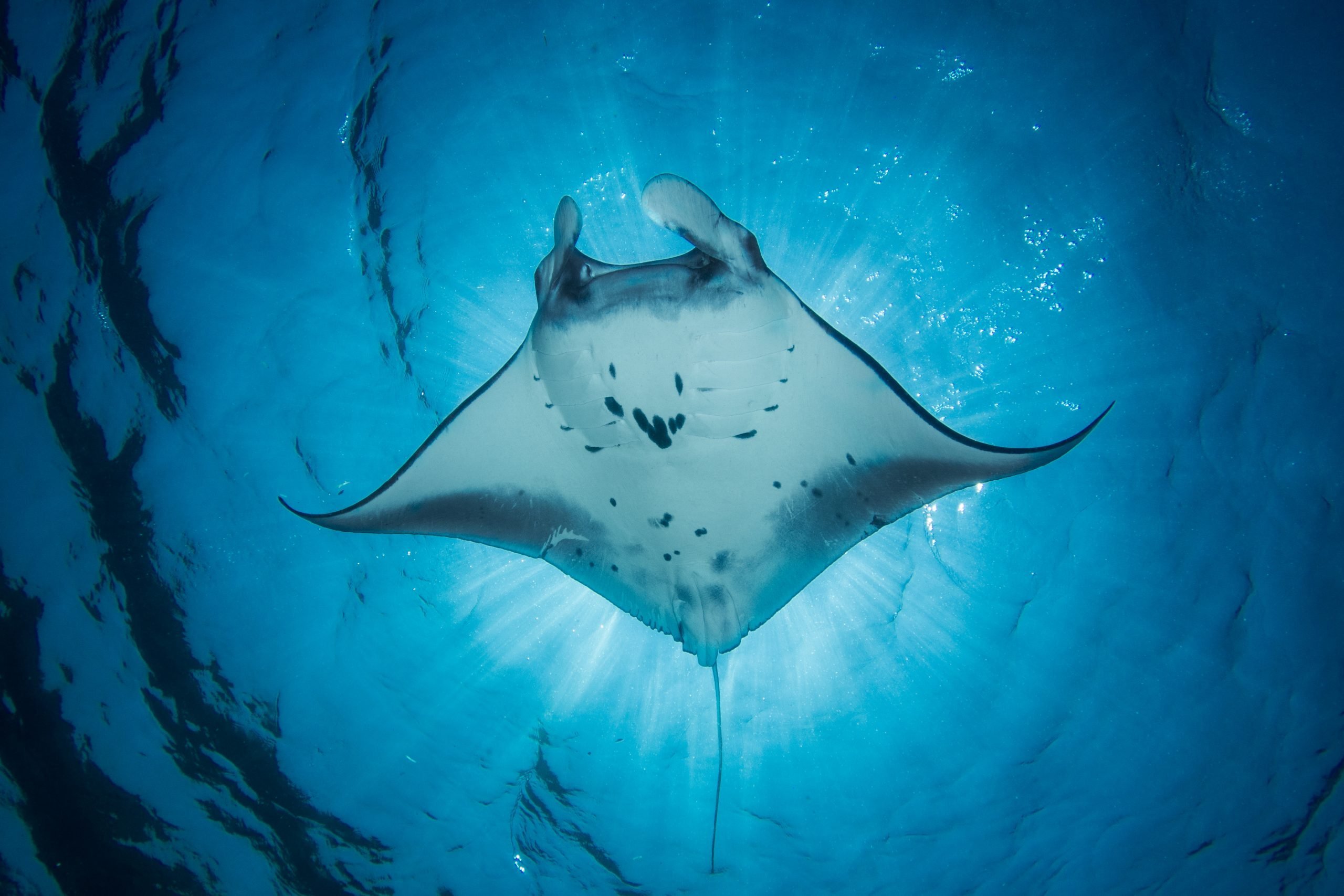
Golden Rays in the Galapagos
Contributed by Charles of McCool Travel
On our Celebrity Cruises sailing in Galapagos we were excited to see all of the animals. Galapagos visitors are required to be escorted by native naturalists but they did not always share the same enthusiasm as the guests. Admittedly, every day for several years they see the same thing in the Galapagos National Park (also a UNESCO World Heritage Site). There are tortoises, penguins, iguanas, blue-footed boobies, seals, and albatross, and so many other unique and fascinating animals. Each and every animal encounter was amazing for us. We snorkeled with seals and hundreds of sea turtles—so many sea turtles that I stopped counting after 75 and could not move in the water without bumping one. But there was one singular animal encounter that made our naturalist giddy with excitement. Upon seeing a splash ahead, his expression changed from “ho-hum this is my job” to “wow, this is something rare.” His voice and demeanor perked up, he instantly grabbed his portable radio and called out to his co-workers and friends, and then announced to the boat that this was an unusual sighting of golden rays (officially called golden cownosed rays). The driver eased the small boast closer so that the dozen passengers could witness the spectacle of the group of golden rays thrashing about and gliding through the water. Soon we were joined by several other boats but we were so lucky to have the experience to ourselves for a few moments. While we saw the golden rays from a boat, I have seen online accounts of people indeed swimming or diving among them. Maybe one of your readers has done so!
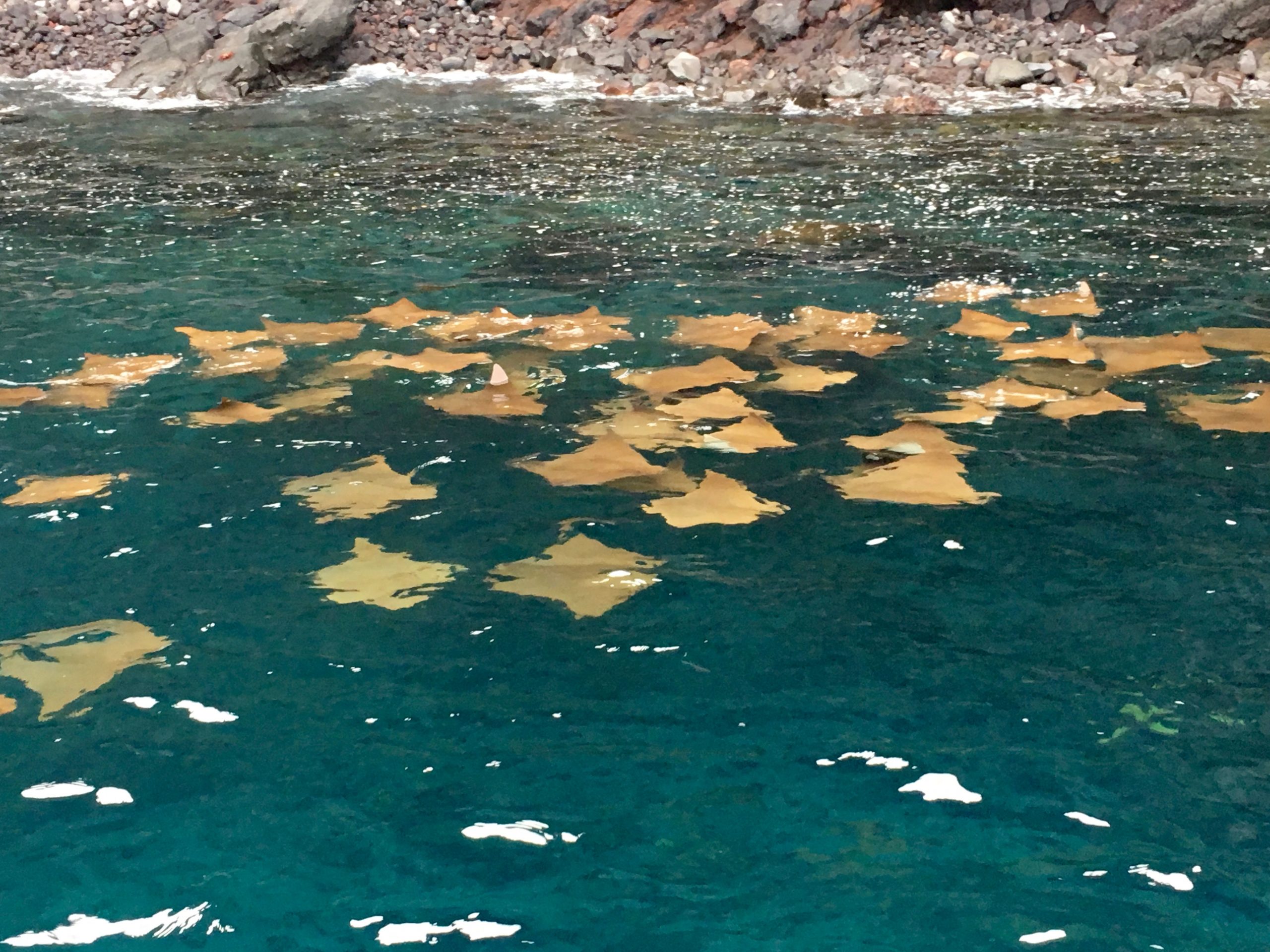
Reptiles
Marine Iguana in the Galapagos
Contributed by Stephanie at Poppin’ Smoke
One of the most unique marine animals you need to see in your life can only be found in the Galapagos Islands: the marine iguana.
The only ocean-going lizard in the world, you can easily spot these reptiles throughout the Galapagos. If you can make the journey to the islands, you will definitely see a marine iguana, because they are often sunning themselves on the shore. Near Academy Bay on the island of Santa Cruz (one of the main tourist areas in the Galapagos), you actually have to take care not to trip over one. Marine iguanas are also very active in the water, so they are fun to observe while snorkeling,
Adult marine iguanas are black most of the year, but during the mating season (January – March), the males can be quite colorful. They may appear to have a white snout or head, but what you are seeing are actually salt crystals that the iguanas have filtered out of their blood through special glands near their nose.
Although they are not the most friendly-looking creatures, marine iguanas are not dangerous. Their diet consists primarily of algae, and they keep to themselves. They are also highly protected under Ecuadorian law. When you see one, snap a picture from a distance, but don’t poke or disturb them.
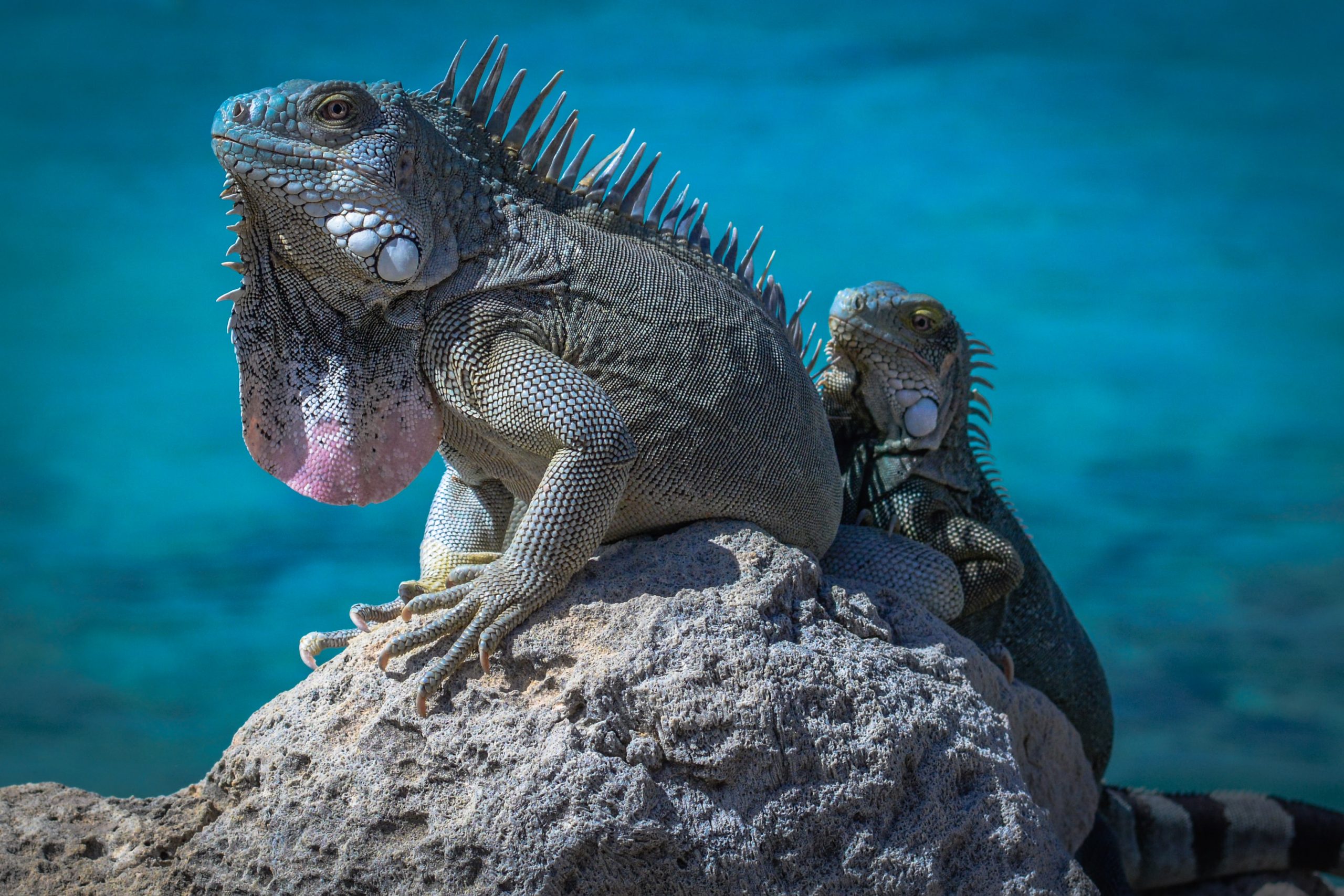
Seals
Elephant & Fur Seals in South Georgia
Contributed by Bella of Passport and Pixels
If you love wildlife and marine animals, one place that definitely needs to be on your bucket list is South Georgia This small island in the middle of the South Atlantic Ocean is 1000 miles from the nearest mainland, and because of this, it’s a haven for wildlife, especially penguins, seabirds and fur and elephant seals.
The huge southern elephant seals, which are the largest seals in the world and can weigh more than 3 tonnes, lie resting in groups on the beaches. They’re hilarious to watch with their enormous fat bodies and beaming moon faces, which look chilled out until a fight breaks out and they start bashing each other with their heads.
Scattered amongst them and further up the beach are the fur seals, which are smaller, more mobile, and more aggressive. To survive in the cold waters around Antarctica they have thick fur coats, which made them prime targets for seal hunters in the 19th and 20th centuries. Male fur seals fight to get a good position on the beach, giving them the best access to females as they come out of the sea, and they’ll defend their position vigorously. You need to watch your back as you walk around, as they can be feisty, and they move surprisingly fast and have a nasty bite!
The only way to get to South Georgia is by boat, usually as part of an Antarctic cruise. These only run during the southern spring and summer (October to March), and you will always see seals during this period. But the best time to go is December to Mid-February when the weather is mildest and breeding season is at its peak. If you visit in January or February there will also be pups, which are some of the cutest baby animals you’ll ever see.
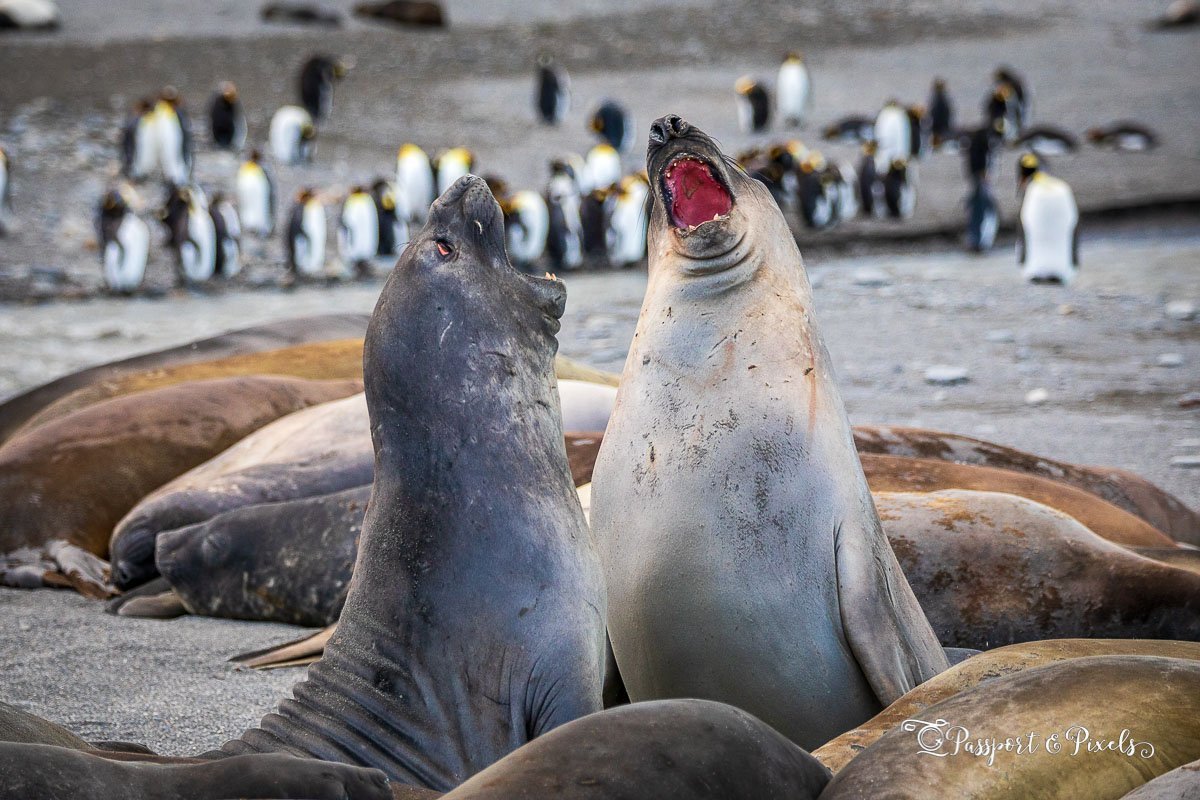
Sharks
Diving with Sharks in Fiji
Contributed by Chantae of The Salt Sirens
While most people hope they don’t encounter a shark while scuba diving, coming eye to eye with these predators in the wild can be one of the most incredible marine encounters you can have. Off of the Coral Coast of Fiji, scuba divers are taken by boat to a dive site where you descend to about 20 meters and look into the blue above you as tens of sharks swim above, all without a cage. Many species of reef sharks, bull sharks, and even tiger sharks often frequent the dive site.
The dive site is in the heart of Shark Reef Marine Reserve, a sanctuary where fishing is banned and a part of each dive fee is given to local villages, who patrol the waters and act as custodians of the reef. Because there is little disturbance, there are hundreds of species of reef fish darting in between the majestic sharks.
The Fiji shark dive is a life-changing experience and has changed how many people view sharks. While sharks are often depicted as “mindless eating machines,” thrashing and targeting anything that moves as prey, the Fiji shark dive reveals that they are actually quite calm and even majestic creatures that should be viewed through a lens that is similar to how we view terrestrial predators, like lions and tigers.
To participate in the Fiji shark dive, you will need to have your open water scuba diving certificate. Because of the nature of the dive, it is recommended that you have your advanced certification and are a confident, capable diver. The dive departs from Beqa Adventure Divers in Pacific Harbor, Fiji.
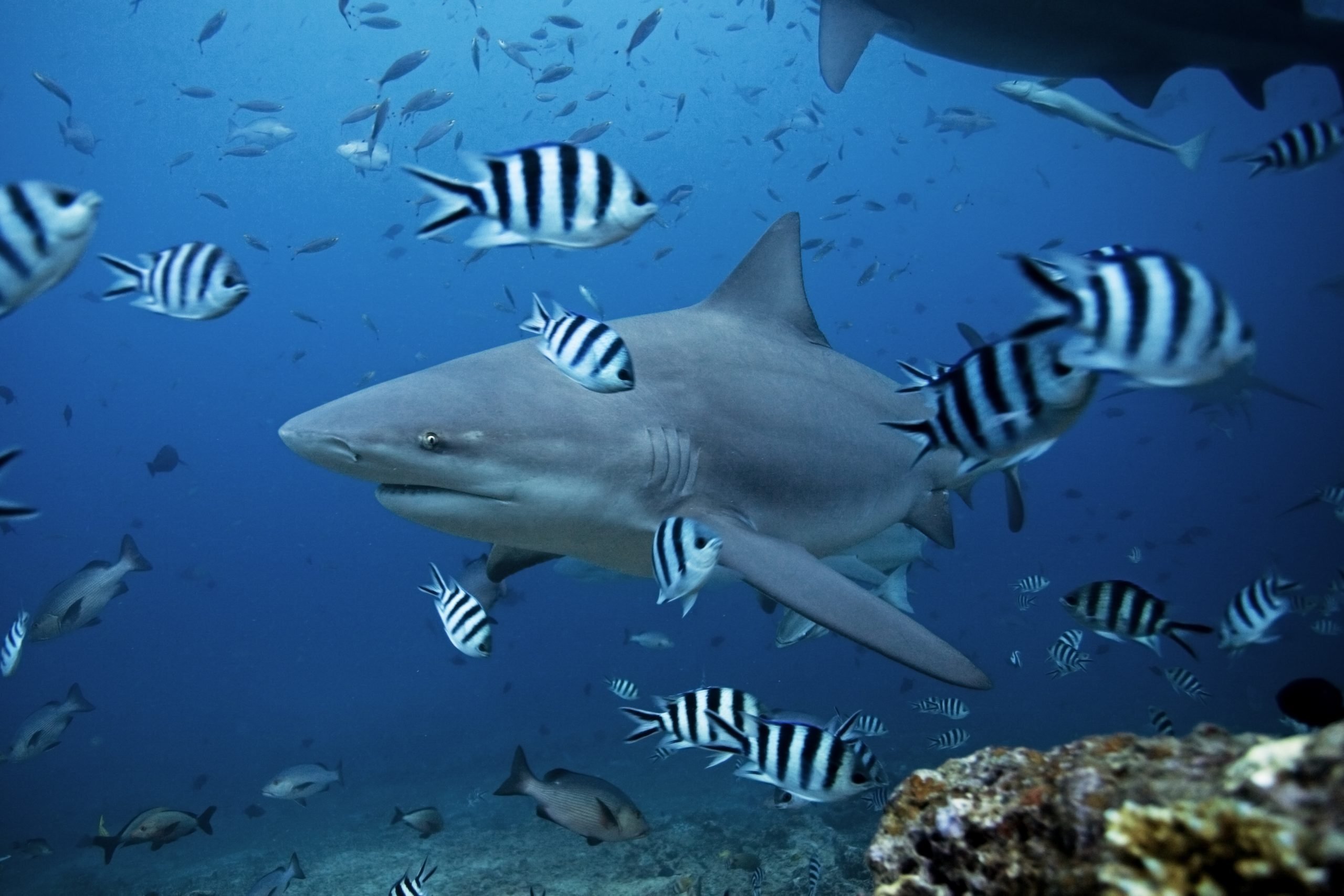
Hammerhead Sharks in the Galapagos
Contributed by Lora Pope of Explore with Lora
Sharks are incredible to see in person. While some can pose a threat, others are harmless, such as the case with hammerhead sharks. These fascinating marine animals are named so for their oddly shaped head, which resembles a hammer.
Hammerhead sharks can be found in tropical destinations around the world, but one of the best places to see them is the Galapagos Islands. Divers can join a day tour in the Galapagos to Gordon Rocks, near the island of Santa Cruz. It’s one of the top dive sites in the islands, known for frequent sightings of large schools of hammerhead sharks as well as a variety of other marine life. Some other marine animals you may see there are Galapagos sharks, oceanic sunfish, sea turtles, stingrays, moray eels, barracudas, and more. It’s not uncommon to see all of these marine animals in one dive!
You can dive in the Galapagos year-round but the best time to go is during the wet season from January to June. In the dry season, the water temperatures are cooler which leads to increased nutrients in the water and poor visibility. Gordan Rocks is a challenging dive site because of the strong current, so you will need to have your advanced diving certification, as well as 25+ logged dives to be able to dive here.
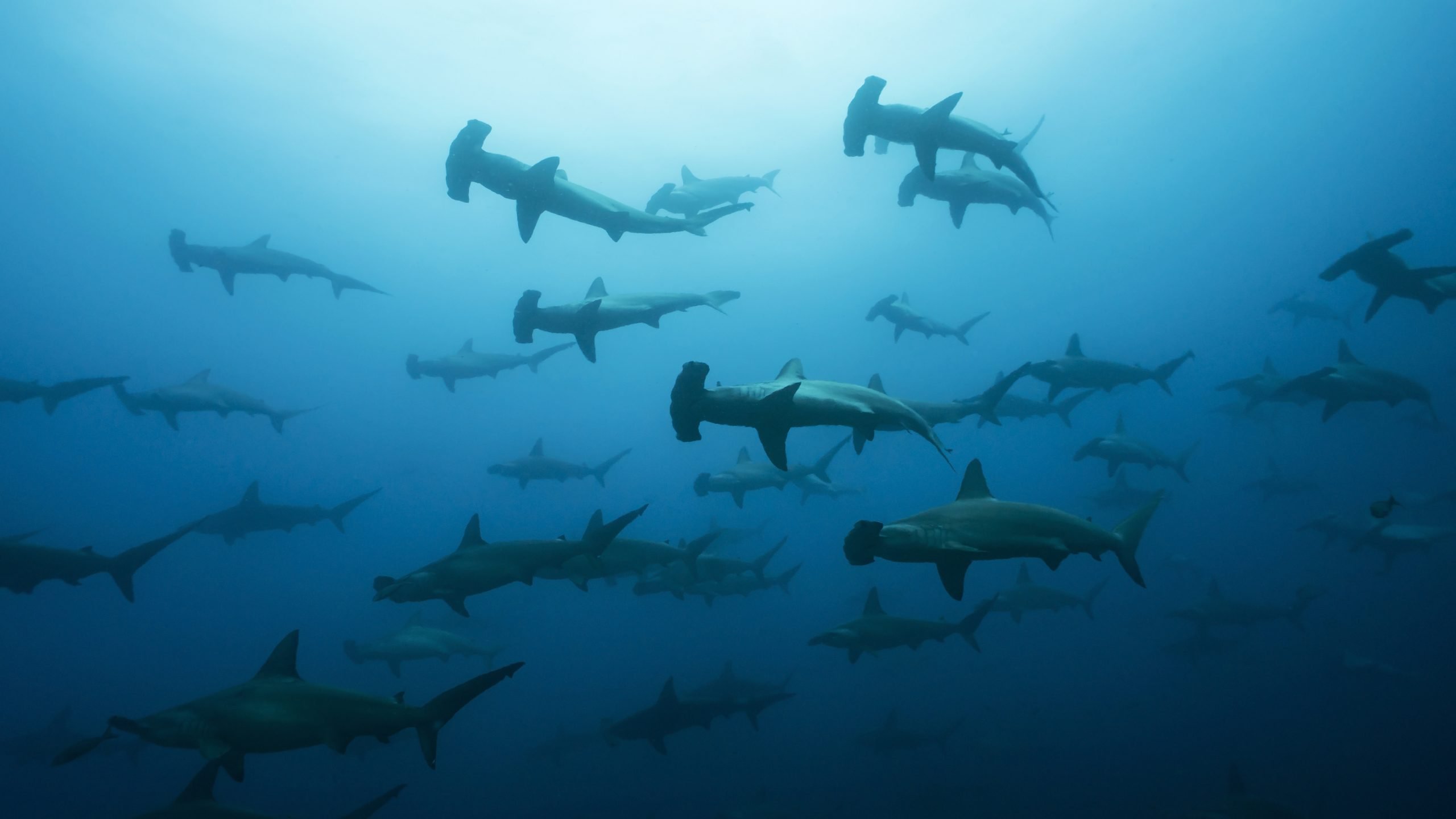
Diving with Bull Sharks in Mexico
Contributed by Ed and Jenn of Coleman Concierge
Just off the coast of Playa Del Carmen, Mexico is a marine animal encounter on every diver’s bucket list – diving with bull sharks. Sharks on some of the most misunderstood creatures of the sea, with hundreds of thousands killed wantonly out of ignorance or barbaric shark finning. Many sharks couldn’t even harm humans if they wanted to.
Bull sharks, however, are man-eaters. The account for the majority of the shark bites, and some say that the historical basis for Jaws was a bull shark and not a great white. Some of the bull shark statistics are because they frequent the shoreline where the people hang out, but still, why would you intentionally seek out these animals?
Our DMs were cautious and gave us advice like staying near the bottom and always keeping our eyes on the sharks. We also made sure not to wear anything that sparkled. But, the sharks off Playa are used to divers, and we found them to be graceful and beautiful. There hasn’t been an incident in 20 years of diving.
We were glad that we went with a no-feed operation too. There are outfits in Playa that put on what we call – the chum show. A DM would descend in chain mail and get his group to hunker down on the bottom, kicking up an underwater sandstorm as they went. He would then work the sharks into a feeding frenzy as he flaunts his masculinity. I much preferred our bucket list shark encounter in a natural state with no chum and more fun.
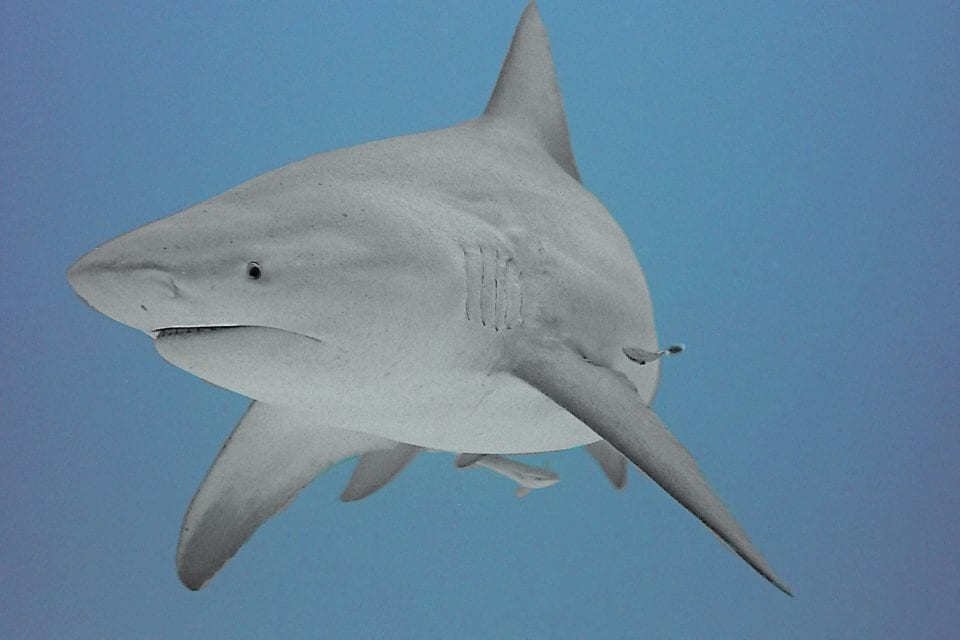
Turtles
Turtles Hatching in Oman
Contributed by Daisy of Beyond My Border
One of the best times to visit Oman is during its turtle hatching season. Between April and August, some 20,000 turtles migrate to the beaches of Oman and lay their eggs before heading back to sea. Within a month, these eggs will hatch en masse. Out will come baby turtles, who will escape from their shells with great physical effort and drag themselves slowly to the ocean nearby
A few hours away from Muscat, this magnificent venture is best experienced along the East Coast of Oman. One such place is the Al Hadd Beach for Turtles, where hatchings often take place. There’s no need for any certifications to visit this natural escape. Simply drive down to Al Hadd and tackle the beach on foot. Since turtle hatchings usually occur at night, it will be best to come here after sunset.
There’s also the option to stay at the nearby Turtle Beach Resort as they often arrange excursions of the entire experience. This may be suitable for those that enjoy the comfort of an organized tour.
Whether it be the ocean views, the sea breeze, or the hundreds of baby sea turtles maneuvering through the sandy beaches of the Arabian Peninsula, definitely include this experience if you are planning a trip to Oman!
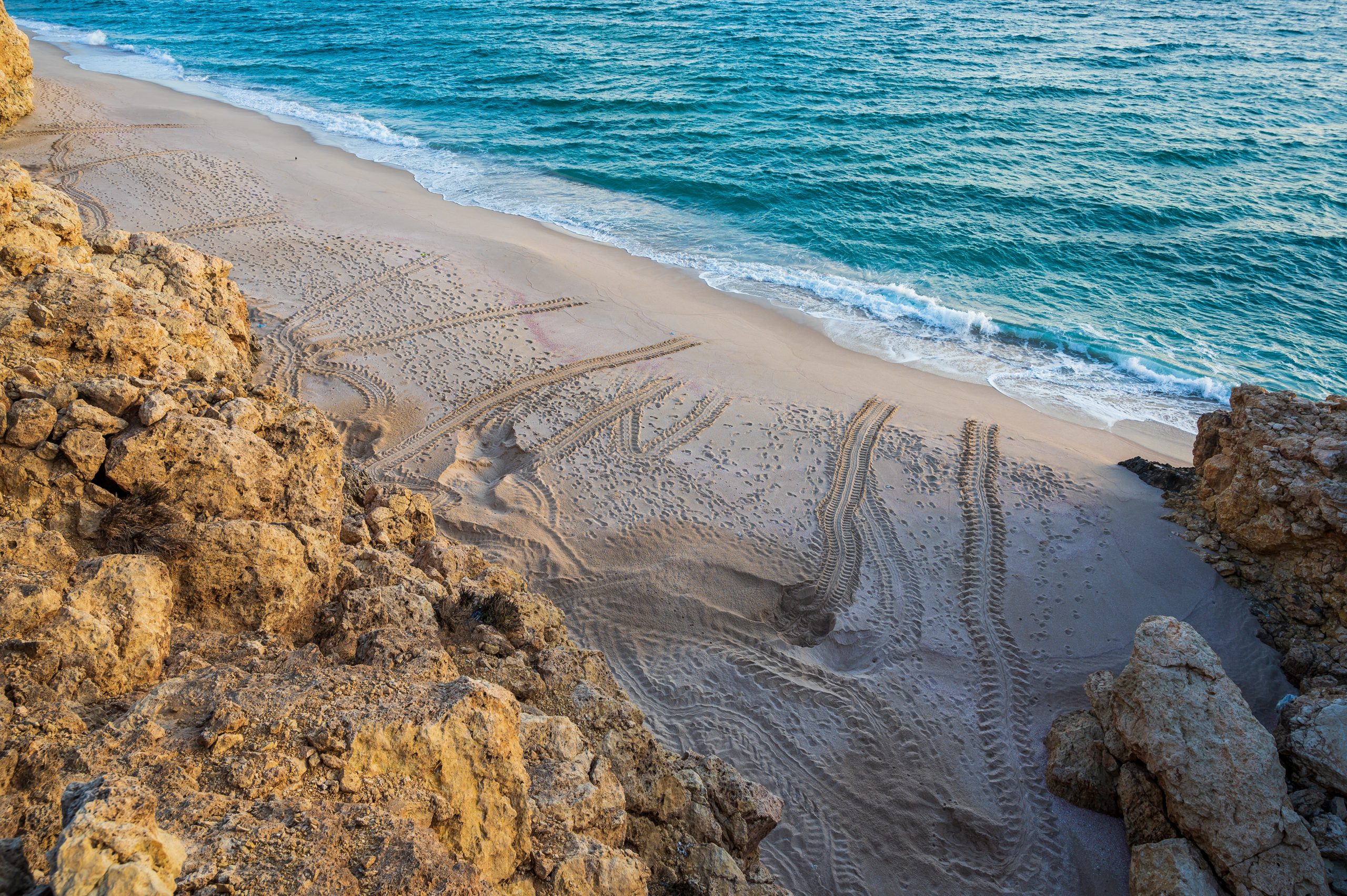
Sea Turtles in Florida
Contributed by Janine of Culture Trekking
I could go on about this topic for ages, the Sea Turtle is my spirit animal in so many ways. Seeing one in the wild in Florida while Scuba Diving off of Singer Island is like seeing your favorite Disney Movie come to life. It is hard not to rip out your regulator and want to scream and frantically swim to them and hug them.
While they don’t say, ‘hey dudette, come ride the wave’, it is fascinating to watch them rummage for food. They aren’t exactly scared of you, having survived since the age of the dinosaurs, and just lazily swim on by.
To see these fascinating creatures in real life is a bit like finding a needle in a haystack. If you go with a reputable company they can usually tell you if a Sea Turtle is near an area they take divers or not. The best time to see them is during the nesting season May to early August, as they are very active near the beaches.
The best place to see them in Florida is near Fort Lauderdale, where they also have a Sea Turtle Conservation effort there called STOP that you can go and help save baby sea turtles from getting smashed in the road.
You don’t need an advanced open water to see them, as many of the dive sites are drift diving right off the shoreline and are easily accessed for open water diving. Just be sure you remember to not fight the current and stay with your dive buddy. It does require a boat dive with a company in order to get to the right locations, so head over to Singer Island and watch the video to see just how much you will enjoy seeing this wonderful creature.
Green and Hawksbill Turtles in the Komodo Islands
Contributed by Cassie of Cassie the hag
Diving in the Komodo Islands is a wonderful way to see marine life. This UNESCO world heritage site is part of the larger Flores region in Indonesia and famous for having some of the best diving in the world. While the large schools of fish here are stunning, the hawksbill and green turtles are the stars of the show. They are majestic. Anyone will tell you the first time seeing a wild turtle is a humbling and magical experience.
This was the second place I ever dived after getting my PADI certification and sections of the National Park are suitable for inexperienced divers. However, those with an advanced PADI are able to do deeper and drift dives. Not a diver? You can also see turtles while snorkeling.
Siaba Besar, suitable for beginners, is a great dive site to see turtles as large numbers call the reef here home. I spotted many turtles on my visit – in fact, I saw more huge green turtles than I ever could have imagined. Some were swimming alongside us, others resting. Dive site Batu Balong is a great place to see Hawksbill turtles.
The best time to see turtles in the Komodo Islands is between mid-April and mid-October (dry season). There are many great 5* dive schools to choose from but I chose Divine Diving. Mostly because their deal came with bean bags and doughnut – the obvious choice.
Other highlights in this region are manta rays and reef sharks. And, when you get back on land, the beastly Komodo dragons are worth a visit too.
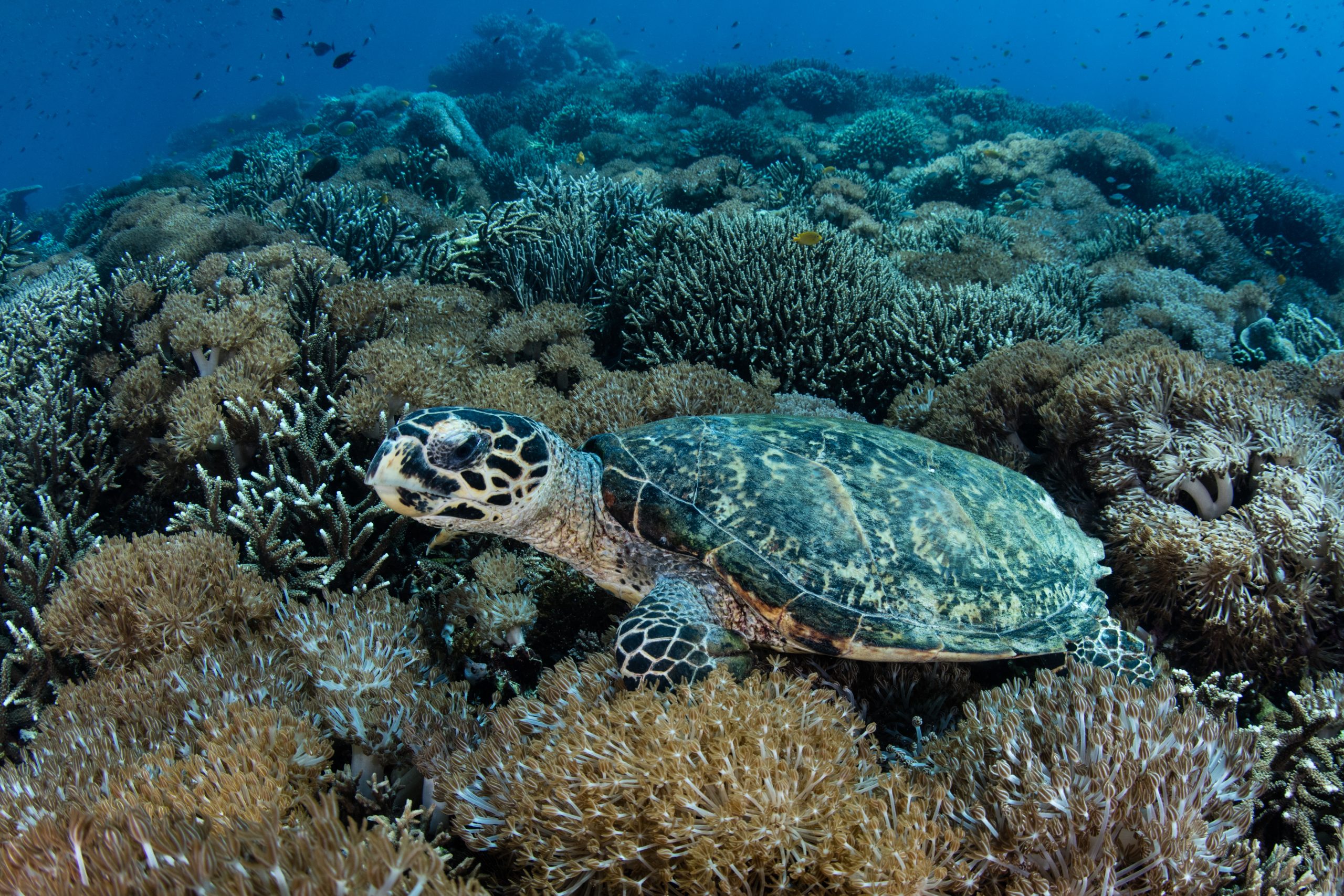
Whales
Swimming with Humpback Whales in Tonga
Contributed by Nicole of Travelgal Nicole
Swimming with humpback whales in Tonga is such an incredible experience I have done it three times now. From July to October every year, humpback whales come to Tonga for their shallow waters so they can birth their calves and wait for them to put on enough weight so they can swim back to Antarctica.
This is my favorite wildlife encounter as this is not whale watching, this is getting in the water with your snorkel gear and swimming with the whales. Usually, you will find a mother and calf hanging out. The mother is on the bottom resting while the calf is playing near the top as they need to take a breathe more often. It’s amazing swimming at the top when the mother decides to come up for a breath and then you really see how big she is up close.
Swimming with humpback whales in Tonga is one of the most amazing encounters. Tonga is the only country where it is legal to swim with the whales and they have strict rules such as staying three meters away. This is adhered to as the locals are running the tours and respect the whales.

Killer Whales in Bremer Canyon, Australia
Contributed by Nina Burakowski of West Australia Explorer
The Bremer Canyon Killer Whale (Orca) Expedition Tours provides one of the world’s most unique interactions with the ocean’s largest predators. The Bremer Canyon is in the Southern Ocean off the coast of Bremer Bay in Australia’s remote southwest region and is one of few places around the world where you can reliably view Killer Whales.
Between January and April each year, this remote location becomes the largest congregation of Killer Whales in the southern hemisphere. There are estimated to be 150 Killer Whales that congregate on the continental shelf around Bremer Canyon each year. The area becomes a spectacular hotbed of marine activity during this time of the year as myriad of marine animals go on a feeding frenzy for squid and other pelagic species. Along with the Killer Whales, other marine species such as sperm whales, pilot whales, dolphins, sunfish, sharks, and sea lions can also be viewed on the tours.
The Bremer Canyon Expedition Tours provide the only opportunity to witness this natural spectacle. During season, the Killer Whale Expedition Tours depart each day from the small seaside town of Bremer Bay. The tours are run by dedicated team of marine scientists and form part of a research study to collect data and information about the animal’s behaviours.
The expedition tours are an all-day experience. They include a presentation about the ecology and biology of the whales as well as other marine animals that may be encountered. Once onboard the vessel, the journey from Bremer Bay township to the edge of the continental shelf takes approximately 1.5 hours.
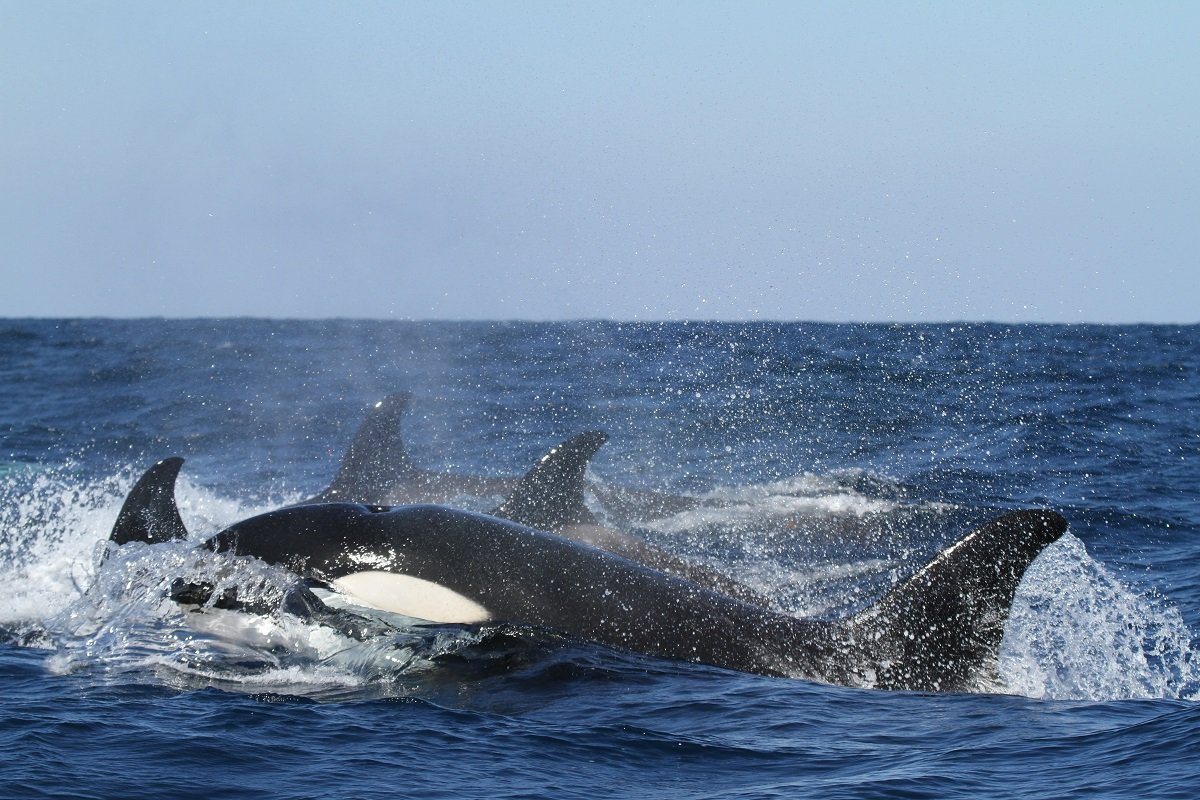
Whales in Monterey Bay, California
Contributed by Dhara of It’s Not About the Miles
The Monterey Peninsula in central California is one of the best places on the planet to go whale watching. Humpback whales, killer whales, and blue whales are common in Monterey Bay, but you can also be lucky enough to see a less common species like the minke whale, the beaked whale, or the fin whale.
As the largest mammals on the planet, whales are stunning to watch. The blue whale is the largest animal to ever inhabit the earth! Seeing a mighty whale “breach” the water is a bucket list experience, and on one whale watching tour from Monterey, we saw not one but several whales breaching, fluking, and spouting.
Whales pass by Monterey Bay during their migration north to south and again from south to north. They feed on krill and small fish and the Monterey Bay is one of the richest sources of these whale foods. That’s why whale watching tours in the Monterey Bay are so productive. Sometimes, whales come right up to the boat, even though the boats are parked at a safe distance!
You can see one type of whale or another pretty much all year round in the Monterey Peninsula. Whale watching tours run from Monterey or from Moss Landing. Bring binoculars and a camera with a good zoom lens!
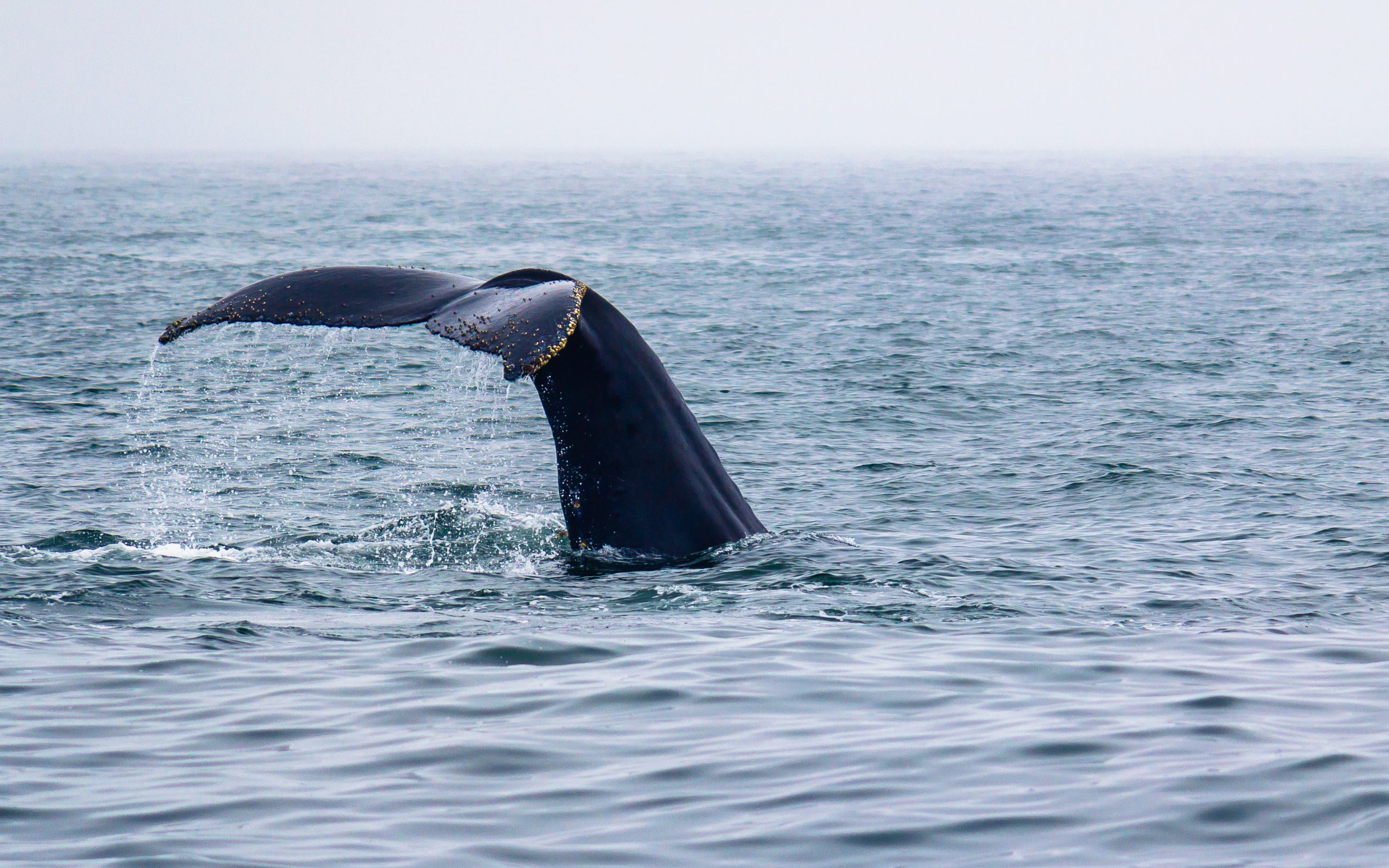
Whale Spotting in South Africa
Contributed by Mariza of Hoponworld
While most people visit South Africa for a chance to see the Big 5 roaming freely in the bush, South Africa’s oceans are home to an incredibly diverse marine life. With more than 37 species of whales and dolphins recorded to call these waters home, it’s not surprising that whale and dolphin spotting is a popular pastime among locals and travelers alike. However, the two most common species of whales you’re likely to see frolicking near the shores are the humpback whale and southern right whale. To catch a glimpse of these gentle giants, you will need to get your timing right. South Africa has a very distinctive whale season, which runs from June to November. And, if you happen to be anywhere along the Cape coast during this period, you’ve come at an excellent time to witness this phenomenon. While there are plenty of whale spotting tours available, there’s really no need to spend money to see these beautiful creatures near the seashores. In fact, all you need to do is head to one of the charming villages that dot the Western Cape’s coastline. One of the most revered whale watching locations in South Africa is Hermanus – a lovely little seaside town located less than 2 hours drive from Cape Town. It’s the perfect place to see these majestic creatures up close as it boasts an incredibly beautiful coastline, unspoiled beaches, hidden tidal pools, and a 12km coastal walking route. It’s best to come in October as the chance to spot whales up close will be much higher. Oh, and travel tip – keep an eye out for the whale crier who blows a kelp horn and carries a signboard with the best daily sighting spots in town.
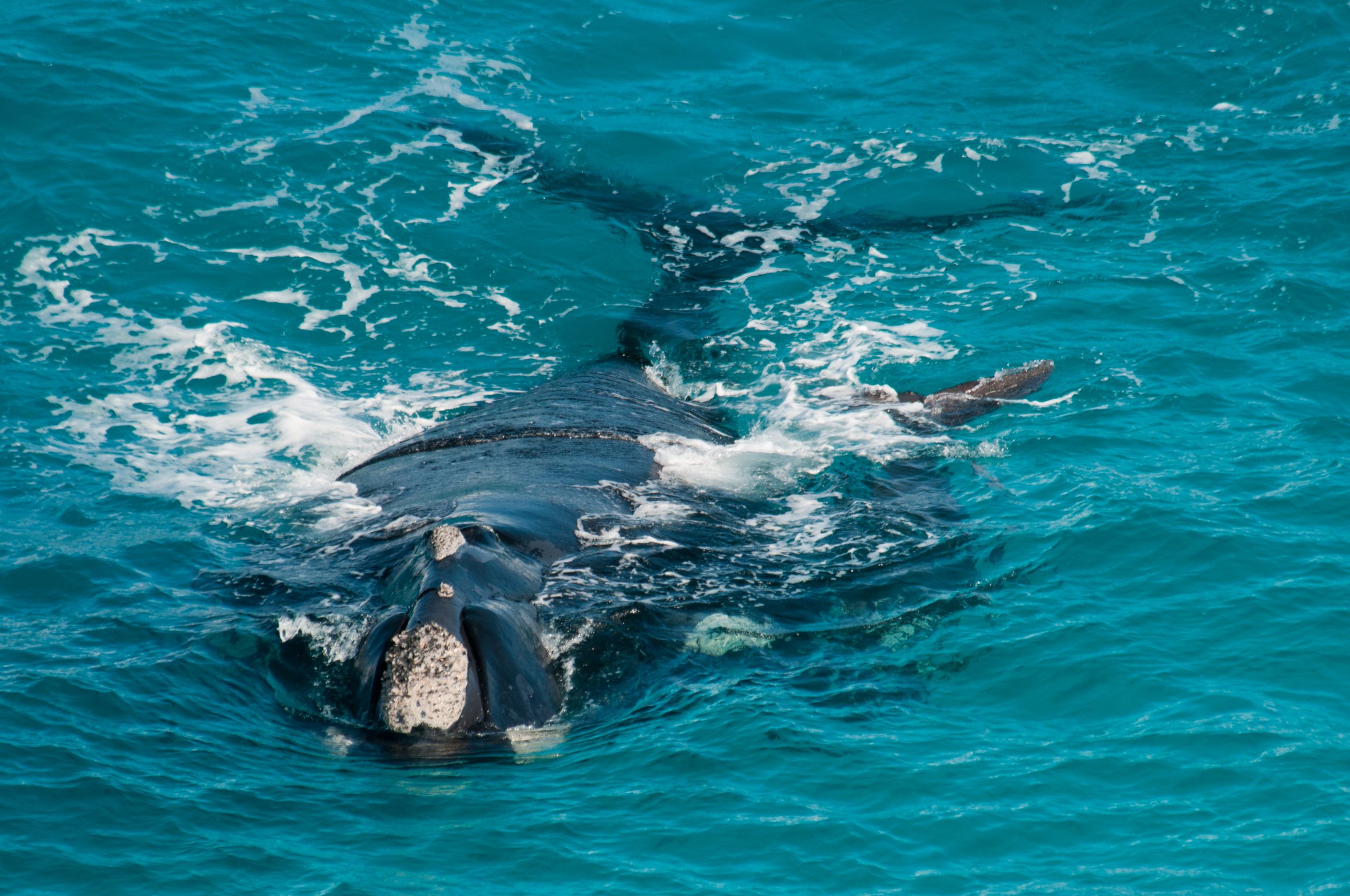
Humpback Whales in Maine
I’ll never forget the first time I saw a humpback whale. You expect it to be magical, but it’s even more magical than you anticipate. Humpback whales are found one every ocean in the world and their name means “big wing of New England” making Maine the perfect spot to do some whale watching.
They were one of the first species protected under Endangered Species Conservation Act as they were nearly hunted out of existence. What was once only hundreds left is now at least 80,000 humpback whales!
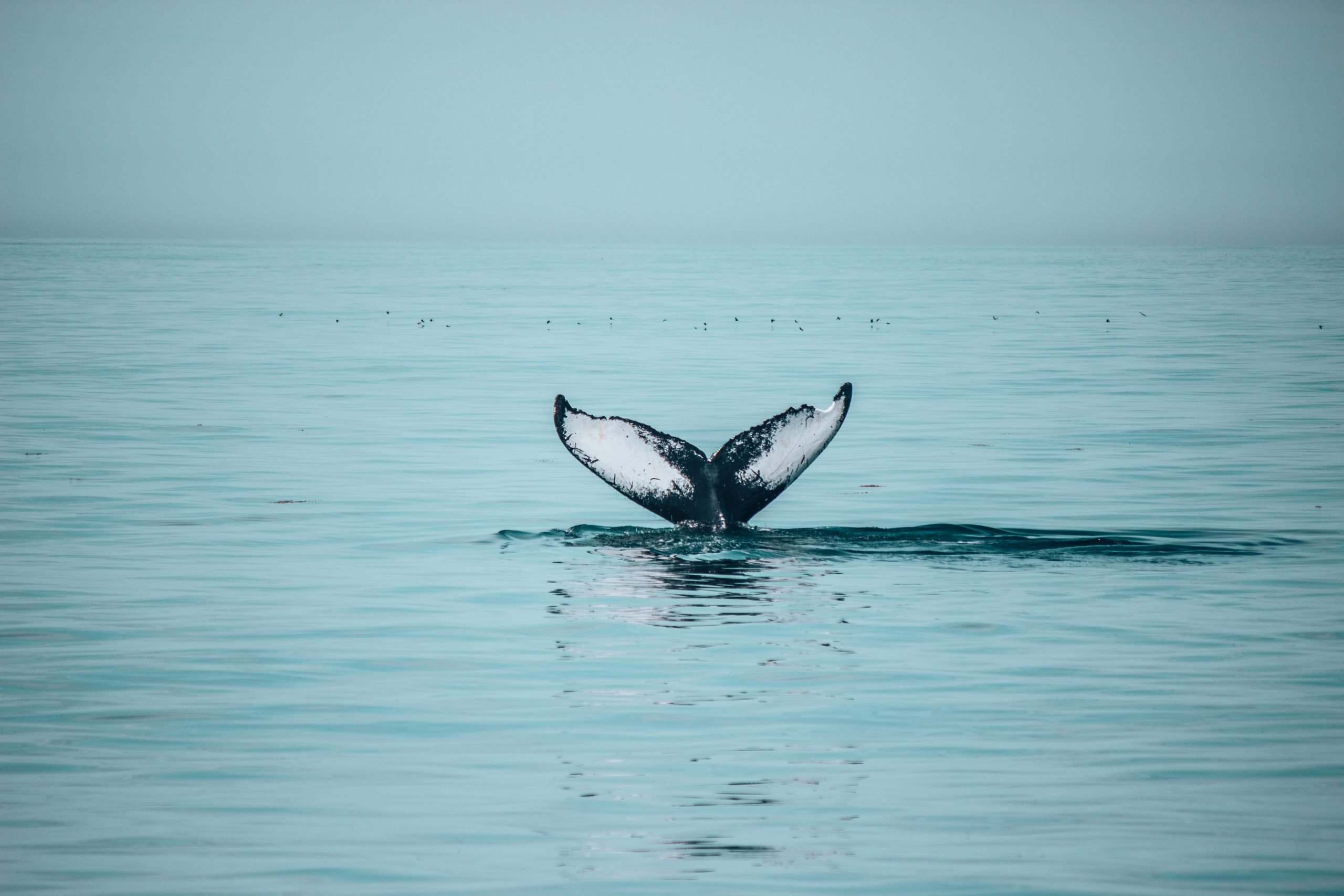
RESOURCES
Planning a trip for the future? Here are my resources.
Interested in starting a blog? Use these resources.
Read my other scuba diving posts.
↓↓↓ PIN FOR LATER ↓↓↓
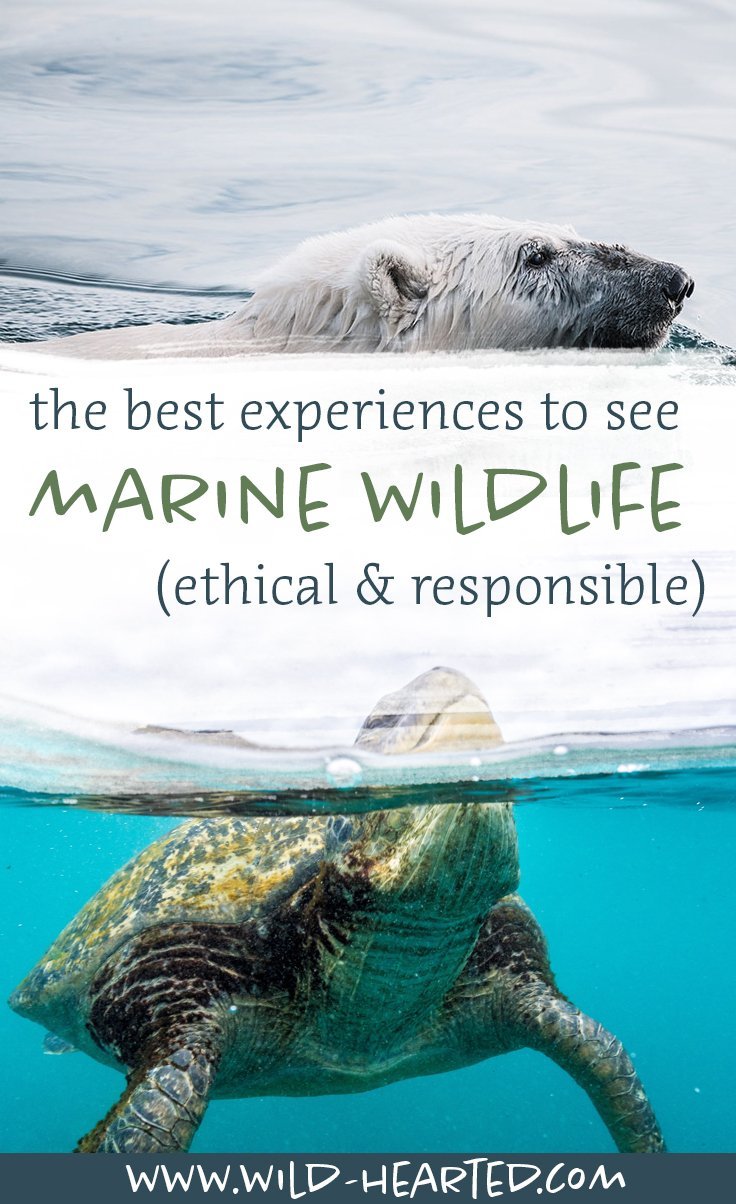
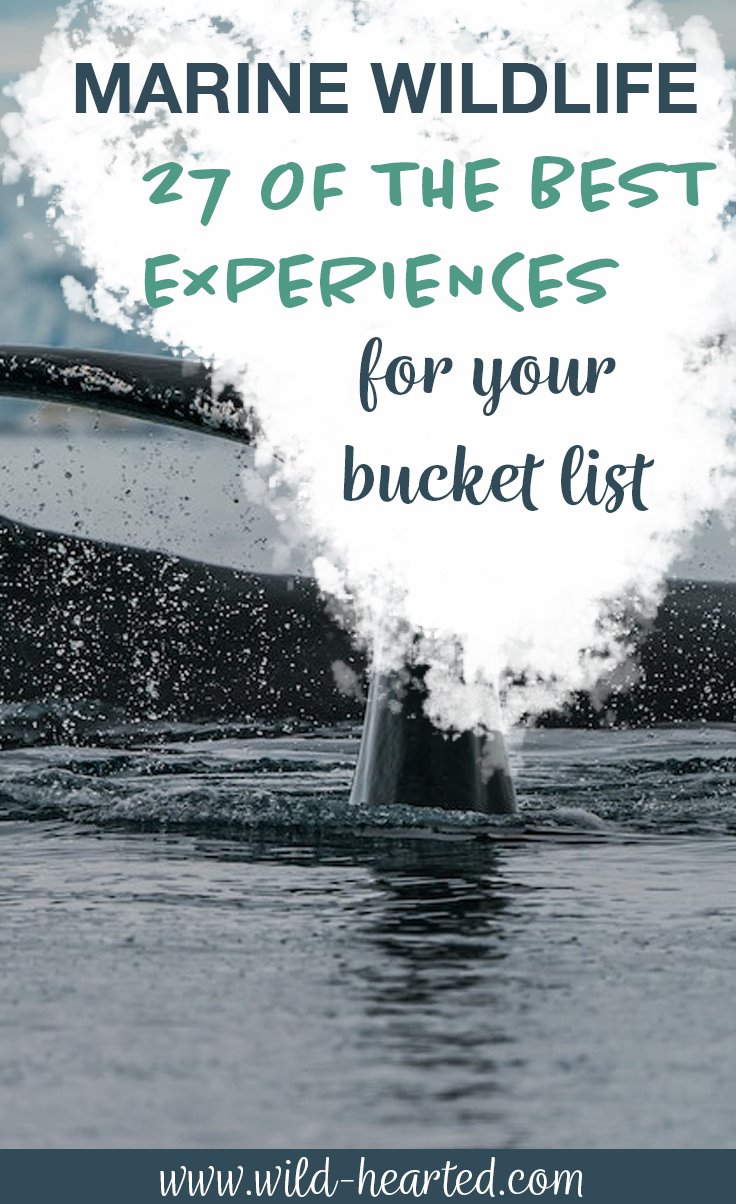
- 9 Weird Things To Do In Dublin, Ireland - April 13, 2024
- 14 Weird Things To Do In Indianapolis, Indiana - April 13, 2024
- Bird Tourism: Getting Started - February 29, 2024


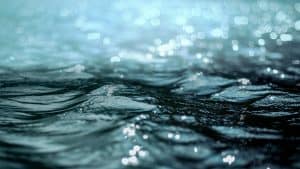


Wow! So many incredible marine wildlife experience to add to my bucket list. Thanks for including me in this awesome round-up!
The swim-with-the-manatees tourism industry in Crystal River, Florida is NOT eco-friendly as claimed. I’m a Crystal River native and manatee advocate and have been video documenting the harassment of manatees here for the past 15 years. The two manatee tour operators mentioned in the article are the ONLY ones out of 40+ businesses that have the blessing of the Save the Manatee Club. Here is an example of the reality of the manatee tours… https://www.youtube.com/watch?v=Wd8YEE6MrXM&t=227s. This is the experience that guides strive to provide. “Passive observation” is a fantasy. To justify swimming with manatees by saying it’s o.k. as long as you book with a reputable guide is ignoring the fact that you are still promoting and supporting the entire industry. “Discover Crystal River” sponsored the author and here is what they say in their advertisement… “Can you touch the manatees?
We’re so glad you asked! Yes you can touch the manatees but there are rules and guidelines for interacting with them. Since manatees are an endangered species, they are protected by law. If you head out on a swimming tour, then your guide will share all the do’s and don’ts for interacting with these precious creatures. Swimmers and divers should minimize noise, avoid splashing, and make slow, deliberate movements. Manatees are very curious and social and they will frequently approach humans in the water. While you may touch a manatee gently on the back or stomach with one hand, it is illegal to touch them with two hands at a time.”
Love this list. There are a couple that I really would like to do like swimming with penguins or pink dolphins. Still haven’t done whale sharks either.
So many things to do.